
ai-notes
notes for software engineers getting up to speed on new AI developments. Serves as datastore for https://latent.space writing, and product brainstorming, but has cleaned up canonical references under the /Resources folder.
Stars: 5135
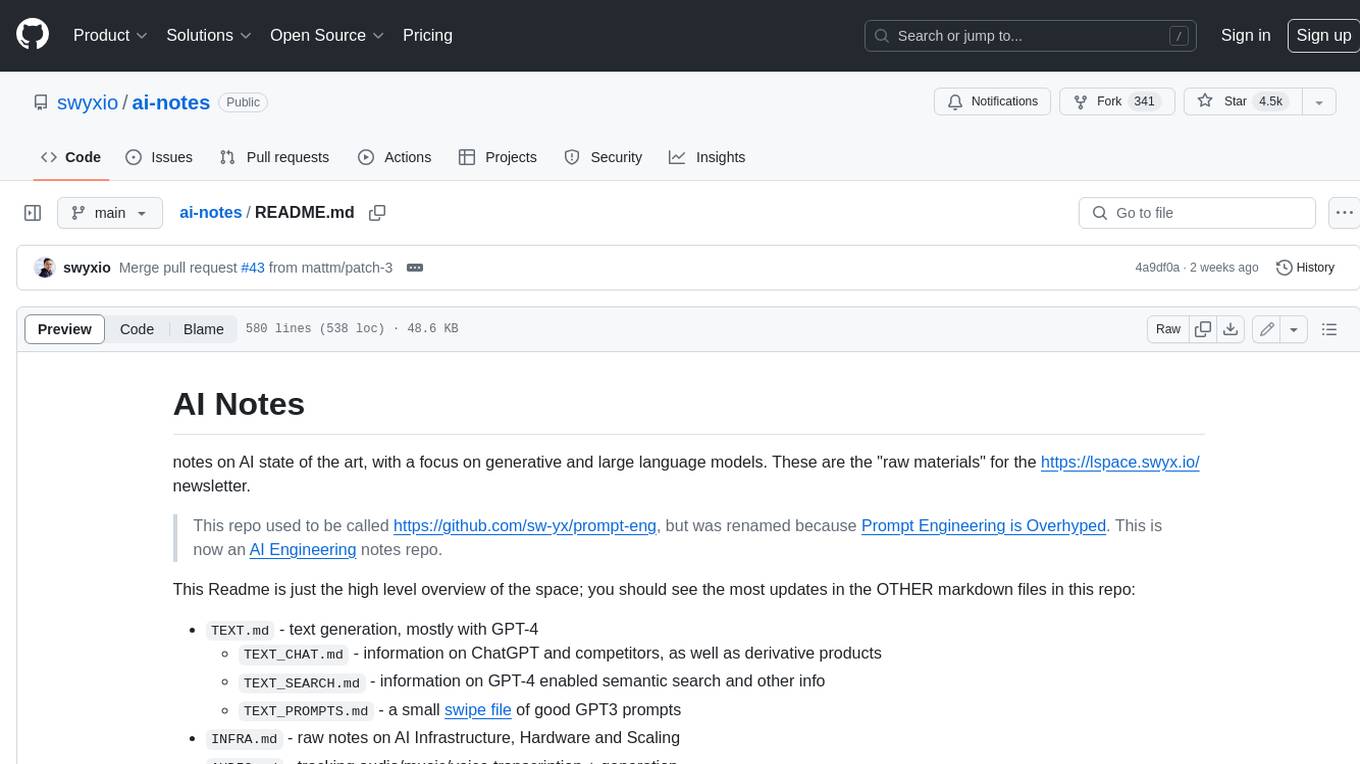
Notes on AI state of the art, with a focus on generative and large language models. These are the "raw materials" for the https://lspace.swyx.io/ newsletter. This repo used to be called https://github.com/sw-yx/prompt-eng, but was renamed because Prompt Engineering is Overhyped. This is now an AI Engineering notes repo.
README:
notes on AI state of the art, with a focus on generative and large language models. These are the "raw materials" for the https://lspace.swyx.io/ newsletter.
This repo used to be called https://github.com/sw-yx/prompt-eng, but was renamed because Prompt Engineering is Overhyped. This is now an AI Engineering notes repo.
This Readme is just the high level overview of the space; you should see the most updates in the OTHER markdown files in this repo:
-
TEXT.md- text generation, mostly with GPT-4-
TEXT_CHAT.md- information on ChatGPT and competitors, as well as derivative products -
TEXT_SEARCH.md- information on GPT-4 enabled semantic search and other info -
TEXT_PROMPTS.md- a small swipe file of good GPT3 prompts
-
-
INFRA.md- raw notes on AI Infrastructure, Hardware and Scaling -
AUDIO.md- tracking audio/music/voice transcription + generation -
CODE.md- codegen models, like Copilot -
IMAGE_GEN.md- the most developed file, with the heaviest emphasis notes on Stable Diffusion, and some on midjourney and dalle.-
IMAGE_PROMPTS.md- a small swipe file of good image prompts
-
- Resources: standing, cleaned up resources that are meant to be permalinked to
-
stub notes - very small/lightweight proto pages of future coverage areas
-
AGENTS.md- tracking "agentic AI" - blog ideas- potential blog post ideas derived from these notes bc
Table of Contents
- images
- video
- img2img of famous movie scenes (lalaland)
- img2img transforming actor with ebsynth + koe_recast
- how ebsynth works https://twitter.com/TomLikesRobots/status/1612047103806545923?s=20
- virtual fashion (karenxcheng)
- seamless tiling images
- evolution of scenes (xander)
- outpainting https://twitter.com/orbamsterdam/status/1568200010747068417?s=21&t=rliacnWOIjJMiS37s8qCCw
- webUI img2img collaboration https://twitter.com/_akhaliq/status/1563582621757898752
- image to video with rotation https://twitter.com/TomLikesRobots/status/1571096804539912192
- "prompt paint" https://twitter.com/1littlecoder/status/1572573152974372864
- audio2video animation of your face https://twitter.com/siavashg/status/1597588865665363969
- physical toys to 3d model + animation https://twitter.com/sergeyglkn/status/1587430510988611584
- music videos
- video killed the radio star, colab This uses OpenAI's Whisper speech-to-text, allowing you to take a YouTube video & create a Stable Diffusion animation prompted by the lyrics in the YouTube video
- Stable Diffusion Videos generates videos by interpolating between prompts and audio
- direct text2video project
- img2img of famous movie scenes (lalaland)
- text-to-3d https://twitter.com/_akhaliq/status/1575541930905243652
- text products
- has a list of usecases at the end https://huyenchip.com/2023/04/11/llm-engineering.html
- Jasper
- GPT for Obsidian https://reasonabledeviations.com/2023/02/05/gpt-for-second-brain/
- gpt3 email https://github.com/sw-yx/gpt3-email and email clustering
- gpt3() in google sheet 2020, 2022 - sheet google sheets https://twitter.com/mehran__jalali/status/1608159307513618433
- https://www.summari.com/ Summari helps busy people read more
- market maps/landscapes
- elad gil 2024 stack chart
- sequoia market map jan 2023, july 2023, sep 2023
- base10 market map https://twitter.com/letsenhance_io/status/1594826383305449491
- matt shumer market map https://twitter.com/mattshumer_/status/1620465468229451776 https://docs.google.com/document/d/1sewTBzRF087F6hFXiyeOIsGC1N4N3O7rYzijVexCgoQ/edit
- nfx https://www.nfx.com/post/generative-ai-tech-5-layers?ref=context-by-cohere
- a16z https://a16z.com/2023/01/19/who-owns-the-generative-ai-platform/
- madrona https://www.madrona.com/foundation-models/
- coatue
- game assets -
- emad thread https://twitter.com/EMostaque/status/1591436813750906882
- scenario.gg https://twitter.com/emmanuel_2m/status/1593356241283125251
- 3d game character modeling example
- MarioGPT https://arxiv.org/pdf/2302.05981.pdf https://www.slashgear.com/1199870/mariogpt-uses-ai-to-generate-endless-super-mario-levels-for-free/ https://github.com/shyamsn97/mario-gpt/blob/main/mario_gpt/level.py
- https://news.ycombinator.com/item?id=36295227
The more advanced GPT3 reads have been split out to https://github.com/sw-yx/ai-notes/blob/main/TEXT.md
-
Bill Gates on AI (tweet)
- "The development of AI is as fundamental as the creation of the microprocessor, the personal computer, the Internet, and the mobile phone. It will change the way people work, learn, travel, get health care, and communicate with each other."
- Steve Yegge on AI for developers
- Karpathy 2023 intro to LLMs (notes from Sarah Chieng)
- Prompt Engineering guide from OpenAI at NeurIPS via Sarah Chieng
- Why this AI moment might be the real deal
- Sam Altman - Moore's Law for Everything
- excellent introduction to foundation models from MSR https://youtu.be/HQI6O5DlyFc
- openAI prompt tutorial https://beta.openai.com/docs/quickstart/add-some-examples
- google LAMDA intro https://aitestkitchen.withgoogle.com/how-lamda-works
- karpathy gradient descent course
- FT visual storytelling on "how transformers work"
- DALLE2 prompt writing book http://dallery.gallery/wp-content/uploads/2022/07/The-DALL%C2%B7E-2-prompt-book-v1.02.pdf
- https://medium.com/nerd-for-tech/prompt-engineering-the-career-of-future-2fb93f90f117
- How to use AI to do stuff across getting information, working with data, and making images
- https://ourworldindata.org/brief-history-of-ai ai progress overview with nice charts
- Jon Stokes' AI Content Generation, Part 1: Machine Learning Basics
- Andrew Ng - Opportunities in AI
- What are transformer models and how do they work? - maybe a bit too high level
- text generation
- humanloop's prompt engineering 101
- Stephen Wolfram's explanations https://writings.stephenwolfram.com/2023/02/what-is-chatgpt-doing-and-why-does-it-work/
- equivalent from jon stokes jonstokes.com/p/the-chat-stack-gpt-4-and-the-near
- https://andymatuschak.org/prompts/
- cohere's LLM university https://docs.cohere.com/docs/llmu
- Jay alammar's guide to all the things: https://llm.university/
- https://www.jonstokes.com/p/chatgpt-explained-a-guide-for-normies for normies
- image generation
- https://wiki.installgentoo.com/wiki/Stable_Diffusion overview
- https://www.reddit.com/r/StableDiffusion/comments/x41n87/how_to_get_images_that_dont_suck_a/
- https://mpost.io/best-100-stable-diffusion-prompts-the-most-beautiful-ai-text-to-image-prompts/
- https://www.kdnuggets.com/2021/03/beginners-guide-clip-model.html
- for nontechnical
- State of AI Report: 2018, 2019, 2020, 2021, 2022
- reverse chronological major events https://bleedingedge.ai/
- What we Know about LLMs - great recap of research
-
Karpathy's 1hr guide to LLMs - summary from Sarah Chieng
-
- What is a large language model (LLM)?
- There are two main components of an LLM
- What does an LLM do?
- How do you create an LLM?
- Stage 1: Model Pre-Training
- Stage 2: Model Fine-tuning
- Stage 2b: [Optional] Additional Fine-tuning
- Stage 3: Model Inference
- Stage 4: [Optional] Supercharging LLMs with Customization
- The Current LLM “Leaderboard”
- The Future of LLMs: What’s Next?
- How to improve LLM performance?
- LLM Scaling Laws
- Self-Improvement
- How to improve LLM abilities?
- Multimodality
- System 1 + 2 Thinking
- How to improve LLM performance?
- The LLM Dark Arts
- Jailbreaking
- Prompt Injecting
- Data Poisoning & Backdoor Attacks
- Evan Morikawa guide to LLM math especially the 5 scaling challenges piece
-
- A Hacker's Guide to Language Models (youtube) Jeremy Howard's 90min complete overview of LLM learnings - starting at the basics: the 3-step pre-training / fine-tuning / classifier ULMFiT approach used in all modern LLMs.
- https://spreadsheets-are-all-you-need.ai
- "Catching up on the weird world of LLMs" - Simon Willison's 40min overview + Open Questions for AI Engineers
- LLMs overview from Flyte
- Clementine Fourrier on How Evals are Done
-
Patterns for building LLM-based systems and products - great recap
- Evals: To measure performance
- RAG: To add recent, external knowledge
- Fine-tuning: To get better at specific tasks
- Caching: To reduce latency & cost
- Guardrails: To ensure output quality
- Defensive UX: To anticipate & manage errors gracefully
- Collect user feedback: To build our data flywheel
-
Vector Databases: A Technical Primer [pdf] very nice slides on Vector DBs
- Missing coverage of hybrid search (vector + lexical). Further discussions
- A16z AI Canon https://a16z.com/2023/05/25/ai-canon/
- Software 2.0: Andrej Karpathy was one of the first to clearly explain (in 2017!) why the new AI wave really matters. His argument is that AI is a new and powerful way to program computers. As LLMs have improved rapidly, this thesis has proven prescient, and it gives a good mental model for how the AI market may progress.
- State of GPT: Also from Karpathy, this is a very approachable explanation of how ChatGPT / GPT models in general work, how to use them, and what directions R&D may take.
- What is ChatGPT doing … and why does it work?: Computer scientist and entrepreneur Stephen Wolfram gives a long but highly readable explanation, from first principles, of how modern AI models work. He follows the timeline from early neural nets to today’s LLMs and ChatGPT.
- Transformers, explained: This post by Dale Markowitz is a shorter, more direct answer to the question “what is an LLM, and how does it work?” This is a great way to ease into the topic and develop intuition for the technology. It was written about GPT-3 but still applies to newer models.
- How Stable Diffusion works: This is the computer vision analogue to the last post. Chris McCormick gives a layperson’s explanation of how Stable Diffusion works and develops intuition around text-to-image models generally. For an even gentler introduction, check out this comic from r/StableDiffusion.
- Explainers
- Deep learning in a nutshell: core concepts: This four-part series from Nvidia walks through the basics of deep learning as practiced in 2015, and is a good resource for anyone just learning about AI.
- Practical deep learning for coders: Comprehensive, free course on the fundamentals of AI, explained through practical examples and code.
- Word2vec explained: Easy introduction to embeddings and tokens, which are building blocks of LLMs (and all language models).
- Yes you should understand backprop: More in-depth post on back-propagation if you want to understand the details. If you want even more, try the Stanford CS231n lecture (course here) on Youtube.
- Courses
- Stanford CS229: Introduction to Machine Learning with Andrew Ng, covering the fundamentals of machine learning.
- Stanford CS224N: NLP with Deep Learning with Chris Manning, covering NLP basics through the first generation of LLMs.
- https://github.com/mlabonne/llm-course
-
https://cims.nyu.edu/~sbowman/eightthings.pdf
- LLMs predictably get more capable with increasing investment, even without targeted innovation.
- Many important LLM behaviors emerge unpredictably as a byproduct of increasing investment.
- LLMs often appear to learn and use representations of the outside world.
- There are no reliable techniques for steering the behavior of LLMs.
- Experts are not yet able to interpret the inner workings of LLMs.
- Human performance on a task isn’t an upper bound on LLM performance.
- LLMs need not express the values of their creators nor the values encoded in web text.
- Brief interactions with LLMs are often misleading.
- simonw highlights https://fedi.simonwillison.net/@simon/110144185463887790
- 10 open challenges in LLM research https://huyenchip.com/2023/08/16/llm-research-open-challenges.html
- openai prompt eng cookbook https://github.com/openai/openai-cookbook/blob/main/techniques_to_improve_reliability.md
- on prompt eng overview https://lilianweng.github.io/posts/2023-03-15-prompt-engineering/
- https://moultano.wordpress.com/2023/06/28/the-many-ways-that-digital-minds-can-know/ comparing search vs ai
- Recap of 2022's major AI developments https://www.deeplearning.ai/the-batch/issue-176/
- DALLE2 asset generation + inpainting https://twitter.com/aifunhouse/status/1576202480936886273?s=20&t=5EXa1uYDPVa2SjZM-SxhCQ
- suhail journey https://twitter.com/Suhail/status/1541276314485018625?s=20&t=X2MVKQKhDR28iz3VZEEO8w
- composable diffusion - "AND" instead of "and" https://twitter.com/TomLikesRobots/status/1580293860902985728
- on BPE tokenization https://towardsdatascience.com/byte-pair-encoding-subword-based-tokenization-algorithm-77828a70bee0 see also google sentencepiece and openai tiktoken
- source in GPT2 source https://github.com/openai/gpt-2/blob/master/src/encoder.py
- note that BPEs are suboptimal https://www.lesswrong.com/posts/dFbfCLZA4pejckeKc/a-mechanistic-explanation-for-solidgoldmagikarp-like-tokens?commentId=9jNdKscwEWBB4GTCQ
- //---------------------------------------------------------------------------------------------------------------- is a single GPT-4 token
- GPT-3.5 crashes when it thinks about useRalativeImagePath too much
- causes math and string character issues https://news.ycombinator.com/item?id=35363769
- and cause issues with evals
- glitch tokens happen when tokenizer has different dataset than LLM
- karpathy talking about why tokenization is messy
- https://platform.openai.com/tokenizer and https://github.com/openai/tiktoken (more up to date: https://tiktokenizer.vercel.app/)
- Wordpiece -> BPE -> SentenceTransformer
- https://observablehq.com/@simonw/gpt-3-token-encoder-decoder
- karpathy wants tokenization to go away https://twitter.com/karpathy/status/1657949234535211009
- positional encoding not needed for decoder only https://twitter.com/a_kazemnejad/status/1664277559968927744?s=20
- creates its own language https://twitter.com/giannis_daras/status/1531693104821985280
- Google Cloud Generative AI Learning Path https://www.cloudskillsboost.google/paths/118
- img2img https://andys.page/posts/how-to-draw/
- on language modeling https://lena-voita.github.io/nlp_course/language_modeling.html and approachable but technical explanation of language generation including sampling from distributions and some mechanistic intepretability (finding neuron that tracks quote state)
- quest for photorealism https://www.reddit.com/r/StableDiffusion/comments/x9zmjd/quest_for_ultimate_photorealism_part_2_colors/
- settings tweaking https://www.reddit.com/r/StableDiffusion/comments/x3k79h/the_feeling_of_discovery_sd_is_like_a_great_proc/
- seed selection https://www.reddit.com/r/StableDiffusion/comments/x8szj9/tutorial_seed_selection_and_the_impact_on_your/
- minor parameter parameter difference study (steps, clamp_max, ETA, cutn_batches, etc) https://twitter.com/KyrickYoung/status/1500196286930292742
- Generative AI: Autocomplete for everything https://noahpinion.substack.com/p/generative-ai-autocomplete-for-everything?sd=pf
- How does GPT Obtain its Ability? Tracing Emergent Abilities of Language Models to their Sources good paper with the development history of the GPT family of models and how the capabilities developed
- https://barryz-architecture-of-agentic-llm.notion.site/Almost-Everything-I-know-about-LLMs-d117ca25d4624199be07e9b0ab356a77
-
https://github.com/Mooler0410/LLMsPracticalGuide
- good curated list of all the impt papers
- https://github.com/eleutherAI/cookbook#the-cookbook Eleuther AI's list of resources for training. compare to https://github.com/google-research/tuning_playbook
- anti hype LLM reading list https://gist.github.com/veekaybee/be375ab33085102f9027853128dc5f0e
-
6 papers from Jason Wei of OpenAI (blog)
- GPT-3 paper (https://arxiv.org/abs/2005.14165)
- chain-of-thought prompting (https://arxiv.org/abs/2201.11903)
- scaling laws, (https://arxiv.org/abs/2001.08361)
- emergent abilities (https://arxiv.org/abs/2206.07682)
- language models can follow both flipped labels and semantically-unrelated labels (https://arxiv.org/abs/2303.03846)
- LLM Paper Notes - notes from the Latent Space paper club by Eugene Yan
- Transformers from scratch https://e2eml.school/transformers.html
- transformers vs LSTM https://medium.com/analytics-vidhya/why-are-lstms-struggling-to-matchup-with-transformers-a1cc5b2557e3
- transformer code walkthru https://twitter.com/mark_riedl/status/1555188022534176768
- transformer familyi https://lilianweng.github.io/posts/2023-01-27-the-transformer-family-v2/
- carmack paper list https://news.ycombinator.com/item?id=34639634
- Transformer models: an introduction and catalog https://arxiv.org/abs/2302.07730
- Deepmind - formal algorithms for transformers https://arxiv.org/pdf/2207.09238.pdf
- Jay Alammar explainers
- karpathy on transformers
- Convergence: The ongoing consolidation in AI is incredible. When I started ~decade ago vision, speech, natural language, reinforcement learning, etc. were completely separate; You couldn't read papers across areas - the approaches were completely different, often not even ML based. In 2010s all of these areas started to transition 1) to machine learning and specifically 2) neural nets. The architectures were diverse but at least the papers started to read more similar, all of them utilizing large datasets and optimizing neural nets. But as of approx. last two years, even the neural net architectures across all areas are starting to look identical - a Transformer (definable in ~200 lines of PyTorch https://github.com/karpathy/minGPT/blob/master/mingpt/model.py…), with very minor differences. Either as a strong baseline or (often) state of the art. (tweetstorm)
- Why Transformers won: The Transformer is a magnificient neural network architecture because it is a general-purpose differentiable computer. It is simultaneously: 1) expressive (in the forward pass) 2) optimizable (via backpropagation+gradient descent) 3) efficient (high parallelism compute graph) tweetstorm
- BabyGPT with two tokens 0/1 and context length of 3, viewing it as a finite state markov chain. It was trained on the sequence "111101111011110" for 50 iterations. The parameters and the architecture of the Transformer modifies the probabilities on the arrows.
- Build GPT from scratch https://www.youtube.com/watch?v=kCc8FmEb1nY
- different GPT from scratch in 60 LOC https://jaykmody.com/blog/gpt-from-scratch/
- Diffusion models from scratch, from a new theoretical perspective - code driven intro of diffusion models
-
137 emergent abilities of large language models
- Emergent few-shot prompted tasks: BIG-Bench and MMLU benchmarks
- Emergent prompting strategies
- Instruction-following
- Scratchpad
- Using open-book knowledge for fact checking
- Chain-of-thought prompting
- Differentiable search index
- Self-consistency
- Leveraging explanations in prompting
- Least-to-most prompting
- Zero-shot chain-of-thought
- Calibration via P(True)
- Multilingual chain-of-thought
- Ask-me-anything prompting
- some pushback - are they a mirage? just dont use harsh metrics
- Images
- Eugene Yan explanation of the Text to Image stack https://eugeneyan.com/writing/text-to-image/
- VQGAN/CLIP https://minimaxir.com/2021/08/vqgan-clip/
- 10 years of Image generation history https://zentralwerkstatt.org/blog/ten-years-of-image-synthesis
- Vision Transformers (ViT) Explained https://www.pinecone.io/learn/vision-transformers/
- negative prompting https://minimaxir.com/2022/11/stable-diffusion-negative-prompt/
- best papers of 2022 https://www.yitay.net/blog/2022-best-nlp-papers
- Predictability and Surprise in Large Generative Models - good survey paper of what we know about scaling and capabilities and rise of LLMs so far
- more prompt eng papers https://github.com/dair-ai/Prompt-Engineering-Guide
- https://creator.nightcafe.studio/vqgan-clip-keyword-modifier-comparison VQGAN+CLIP Keyword Modifier Comparison
- History of Transformers
- richard socher on their contribution to attention mechanism leading up to transformers https://overcast.fm/+r1P4nKfFU/1:00:00
- https://kipp.ly/blog/transformer-taxonomy/ This document is my running literature review for people trying to catch up on AI. It covers 22 models, 11 architectural changes, 7 post-pre-training techniques and 3 training techniques (and 5 things that are none of the above)
-
Understanding Large Language Models A Cross-Section of the Most Relevant Literature To Get Up to Speed
- giving credit to Bandanau et al (2014), which I believe first proposed the concept of applying a Softmax function over token scores to compute attention, setting the stage for the original transformer by Vaswani et al (2017). https://news.ycombinator.com/item?id=35589756
- https://finbarrtimbers.substack.com/p/five-years-of-progress-in-gpts GPT1/2/3, Megatron, Gopher, Chinchilla, PaLM, LLaMa
- good summary paper (8 things to know) https://cims.nyu.edu/~sbowman/eightthings.pdf
- Huggingface MOE explainer
- https://blog.alexalemi.com/kl-is-all-you-need.html
We compared 126 keyword modifiers with the same prompt and initial image. These are the results.
- https://creator.nightcafe.studio/collection/8dMYgKm1eVXG7z9pV23W
- Google released PartiPrompts as a benchmark: https://parti.research.google/ "PartiPrompts (P2) is a rich set of over 1600 prompts in English that we release as part of this work. P2 can be used to measure model capabilities across various categories and challenge aspects."
- Video tutorials
- History of papers
- 2008: Unified Architecture for NLP (Collobert-Weston) https://twitter.com/ylecun/status/1611921657802768384
- 2015: Semi-supervised sequence learning https://twitter.com/deliprao/status/1611896130589057025?s=20
- 2017: Transformers (Vaswani et al)
- 2018: GPT (Radford et al)
- Misc
- StabilityAI CIO perspective https://danieljeffries.substack.com/p/the-turning-point-for-truly-open?sd=pf
- https://github.com/awesome-stable-diffusion/awesome-stable-diffusion
- https://github.com/microsoft/LMOps guide to msft prompt research
- gwern's behind the scenes discussion of Bing, GPT4, and the Microsoft-OpenAI relationship https://www.lesswrong.com/posts/jtoPawEhLNXNxvgTT/bing-chat-is-blatantly-aggressively-misaligned
- https://gist.github.com/rain-1/eebd5e5eb2784feecf450324e3341c8d
- https://github.com/underlines/awesome-marketing-datascience/blob/master/awesome-ai.md#llama-models
- https://github.com/imaurer/awesome-decentralized-llm
- Discords (see https://buttondown.email/ainews for daily email recaps, updated live)
- Latent Space Discord (ours!)
- General hacking and learning
- ChatGPT Hackers Discord
- Alignment Lab AI Discord
- Nous Research Discord
- DiscoLM Discord
- Karpathy Discord (inactive)
- HuggingFace Discord
- Skunkworks AI Discord (new)
- Jeff Wang/LLM Perf enthusiasts discord
- CUDA Mode (Mark Saroufim) see Youtube and GitHub
- Art
- StableDiffusion Discord
- Deforum Discord https://discord.gg/upmXXsrwZc
- Lexica Discord https://discord.com/invite/bMHBjJ9wRh
- AI research
- LAION discord https://discord.gg/xBPBXfcFHd
- Eleuther discord: https://www.eleuther.ai/get-involved/ (primer)
- Various startups
- Perplexity Discord https://discord.com/invite/kWJZsxPDuX
- Midjourney's discord
- how to use midjourney v4 https://twitter.com/fabianstelzer/status/1588856386540417024?s=20&t=PlgLuGAEEds9HwfegVRrpg
-
https://stablehorde.net/
- Agents
- AutoGPT discord
- BabyAGI discord
- Agents
*Unknown to many people, a growing amount of alpha is now outside of Arxiv, sources include but are not limited to: https://github.com/trending, HN, that niche Discord server, anime profile picture anons on X, reddit *- K
This list will be out of date but will get you started. My live list of people to follow is at: https://twitter.com/i/lists/1585430245762441216
- Researchers/Developers
- https://twitter.com/_jasonwei
- https://twitter.com/johnowhitaker/status/1565710033463156739
- https://twitter.com/altryne/status/1564671546341425157
- https://twitter.com/SchmidhuberAI
- https://twitter.com/nearcyan
- https://twitter.com/karinanguyen_
- https://twitter.com/abhi_venigalla
- https://twitter.com/advadnoun
- https://twitter.com/polynoamial
- https://twitter.com/vovahimself
- https://twitter.com/sarahookr
- https://twitter.com/shaneguML
- https://twitter.com/MaartenSap
- https://twitter.com/ethanCaballero
- https://twitter.com/ShayneRedford
- https://twitter.com/seb_ruder
- https://twitter.com/rasbt
- https://twitter.com/wightmanr
- https://twitter.com/GaryMarcus
- https://twitter.com/ylecun
- https://twitter.com/karpathy
- https://twitter.com/pirroh
- https://twitter.com/eerac
- https://twitter.com/teknium
- https://twitter.com/alignment_lab
- https://twitter.com/picocreator
- https://twitter.com/charlespacker
- https://twitter.com/ldjconfirmed
- https://twitter.com/nisten
- https://twitter.com/far__el
- https://twitter.com/i/lists/1713824630241202630
- News/Aggregators
- https://twitter.com/ai__pub
- https://twitter.com/WeirdStableAI
- https://twitter.com/multimodalart
- https://twitter.com/LastWeekinAI
- https://twitter.com/paperswithcode
- https://twitter.com/DeepLearningAI_
- https://twitter.com/dl_weekly
- https://twitter.com/slashML
- https://twitter.com/_akhaliq
- https://twitter.com/aaditya_ai
- https://twitter.com/bentossell
- https://twitter.com/johnvmcdonnell
- Founders/Builders/VCs
- https://twitter.com/levelsio
- https://twitter.com/goodside
- https://twitter.com/c_valenzuelab
- https://twitter.com/Raza_Habib496
- https://twitter.com/sharifshameem/status/1562455690714775552
- https://twitter.com/genekogan/status/1555184488606564353
- https://twitter.com/levelsio/status/1566069427501764613?s=20&t=camPsWtMHdSSEHqWd0K7Ig
- https://twitter.com/amanrsanger
- https://twitter.com/ctjlewis
- https://twitter.com/sarahcat21
- https://twitter.com/jackclarkSF
- https://twitter.com/alexandr_wang
- https://twitter.com/rameerez
- https://twitter.com/scottastevenson
- https://twitter.com/denisyarats
- Stability
- OpenAI
- HuggingFace
- Artists
- Other
- Bots and Apps
- Narrow, tedium domain usecases https://twitter.com/WillManidis/status/1584900092615528448 and https://twitter.com/WillManidis/status/1584900100480192516
- antihype https://twitter.com/alexandr_wang/status/1573302977418387457
- antihype https://twitter.com/fchollet/status/1612142423425138688?s=46&t=pLCNW9pF-co4bn08QQVaUg
- prompt eng memes
- things stablediffusion struggles with https://opguides.info/posts/aiartpanic/
- New Google
- New Powerpoint
- via emad
- Appending prompts by default in UI
- DALLE: https://twitter.com/levelsio/status/1588588688115912705?s=20&t=0ojpGmH9k6MiEDyVG2I6gg
- There have been two previous winters, one 1974-1980 and one 1987-1993. https://www.erichgrunewald.com/posts/the-prospect-of-an-ai-winter/. bit more commentary here. related - AI Effect - "once it works its not AI"
- It's just matrix multiplication/stochastic parrots
- Even LLM skeptic Yann LeCun says LLMs have some level of understanding: https://twitter.com/ylecun/status/1667947166764023808
- Gary Marcus’ “Deep Learning is Hitting a Wall” https://nautil.us/deep-learning-is-hitting-a-wall-238440/ pushed symbolic systems
- "guo lai ren" antihypers-> worriers
- NSFW filter https://vickiboykis.com/2022/11/18/some-notes-on-the-stable-diffusion-safety-filter/
- On "AI Art Panic" https://opguides.info/posts/aiartpanic/
- Yannick influencing OPENRAIL-M https://www.youtube.com/watch?v=W5M-dvzpzSQ
- art schools accepting AI art https://twitter.com/DaveRogenmoser/status/1597746558145265664
- DRM issues https://undeleted.ronsor.com/voice.ai-gpl-violations-with-a-side-of-drm/
- stealing art https://stablediffusionlitigation.com
- http://www.stablediffusionfrivolous.com/
- stable attribution https://news.ycombinator.com/item?id=34670136
- coutner argument for disney https://twitter.com/jonst0kes/status/1616219435492163584?s=46&t=HqQqDH1yEwhWUSQxYTmF8w
- research on stable diffusion copying https://twitter.com/officialzhvng/status/1620535905298817024?s=20&t=NC-nW7pfDa8nyRD08Lx1Nw This paper used Stable Diffusion to generate 175 million images over 350,000 prompts and only found 109 near copies of training data. Am I right that my main takeaway from this is how good Stable Diffusion is at not memorizing training examples?
- scraping content
- Licensing
- Diversity and Equity
- sexualizing minorities https://twitter.com/lanadenina/status/1680238883206832129 the reason is porn is good at bodies
- OpenAI tacking on "black" randomly to make DallE diverse
- Privacy - confidential computing https://www.edgeless.systems/blog/how-confidential-computing-and-ai-fit-together/
- AI taking jobs https://donaldclarkplanb.blogspot.com/2024/02/this-is-why-idea-that-ai-will-just.html
- Anthropic - https://arxiv.org/pdf/2112.00861.pdf
- Helpful: attempt to do what is ask. concise, efficient. ask followups. redirect bad questions.
- Honest: give accurate information, express uncertainty. don't imitate responses expected from an expert if it doesn't have the capabilities/knowledge
- Harmless: not offensive/discriminatory. refuse to assist dangerous acts. recognize when providing sensitive/consequential advice
- criticism and boundaries as future direction https://twitter.com/davidad/status/1628489924235206657?s=46&t=TPVwcoqO8qkc7MuaWiNcnw
- Just Eliezer entire body of work
- https://twitter.com/esyudkowsky/status/1625922986590212096
- agi list of lethalities https://www.lesswrong.com/posts/uMQ3cqWDPHhjtiesc/agi-ruin-a-list-of-lethalities
- note that eliezer has made controversial comments in the past and also in recent times (TIME article)
- Connor Leahy may be a more sane/measured/technically competent version of yud https://overcast.fm/+aYlOEqTJ0
- it's not just paperclip factories
- https://www.lesswrong.com/posts/HBxe6wdjxK239zajf/what-failure-looks-like
- the 6 month pause letter
- https://futureoflife.org/open-letter/pause-giant-ai-experiments/
- yann lecun vs andrew ng https://www.youtube.com/watch?v=BY9KV8uCtj4
- https://scottaaronson.blog/?p=7174
- emily bender response
- Geoffrey Hinton leaving Google
- followed up by one sentence public letter https://www.nytimes.com/2023/05/30/technology/ai-threat-warning.html
- xrisk - Is avoiding extinction from AI really an urgent priority? (link)
- OpenAI superalignment https://www.youtube.com/watch?v=ZP_N4q5U3eE
- chinese regulation https://www.chinalawtranslate.com/en/overview-of-draft-measures-on-generative-ai/
- https://twitter.com/mmitchell_ai/status/1647697067006111745?s=46&t=90xQ8sGy63D2OtiaoGJuww
- China is the only major world power that explicitly regulates generative AI
- italy banning chatgpt
-
- At its annual meeting in Japan, the Group of Seven (G7), an informal bloc of industrialized democratic governments, announced the Hiroshima Process, an intergovernmental task force empowered to investigate risks of generative AI. G7 members, which include Canada, France, Germany, Italy, Japan, the United Kingdom, and the United States, vowed to craft mutually compatible laws and regulate AI according to democratic values. These include fairness, accountability, transparency, safety, data privacy, protection from abuse, and respect for human rights.
- U.S. President Joe Biden issued a strategic plan for AI. The initiative calls on U.S. regulatory agencies to develop public datasets, benchmarks, and standards for training, measuring, and evaluating AI systems.
- Earlier this month, France’s data privacy regulator announced a framework for regulating generative AI.
- regulation vs Xrisk https://1a3orn.com/sub/essays-regulation-stories.html
- Multimodal Prompt Injection in GPT4V
- Whisper
- https://huggingface.co/spaces/sensahin/YouWhisper YouWhisper converts Youtube videos to text using openai/whisper.
- https://twitter.com/jeffistyping/status/1573145140205846528 youtube whipserer
- multilingual subtitles https://twitter.com/1littlecoder/status/1573030143848722433
- video subtitles https://twitter.com/m1guelpf/status/1574929980207034375
- you can join whisper to stable diffusion for reasons https://twitter.com/fffiloni/status/1573733520765247488/photo/1
- known problems https://twitter.com/lunixbochs/status/1574848899897884672 (edge case with catastrophic failures)
- textually guided audio https://twitter.com/FelixKreuk/status/1575846953333579776
- Codegen
- pdf to structured data - Impira used t to do it (dead link: https://www.impira.com/blog/hey-machine-whats-my-invoice-total) but if you look hard enough on twitter there are some alternatives
- text to Human Motion diffusion https://twitter.com/GuyTvt/status/1577947409551851520
- abs: https://arxiv.org/abs/2209.14916
- project page: https://guytevet.github.io/mdm-page/
For Tasks:
Click tags to check more tools for each tasksFor Jobs:
Alternative AI tools for ai-notes
Similar Open Source Tools

ai-notes
Notes on AI state of the art, with a focus on generative and large language models. These are the "raw materials" for the https://lspace.swyx.io/ newsletter. This repo used to be called https://github.com/sw-yx/prompt-eng, but was renamed because Prompt Engineering is Overhyped. This is now an AI Engineering notes repo.
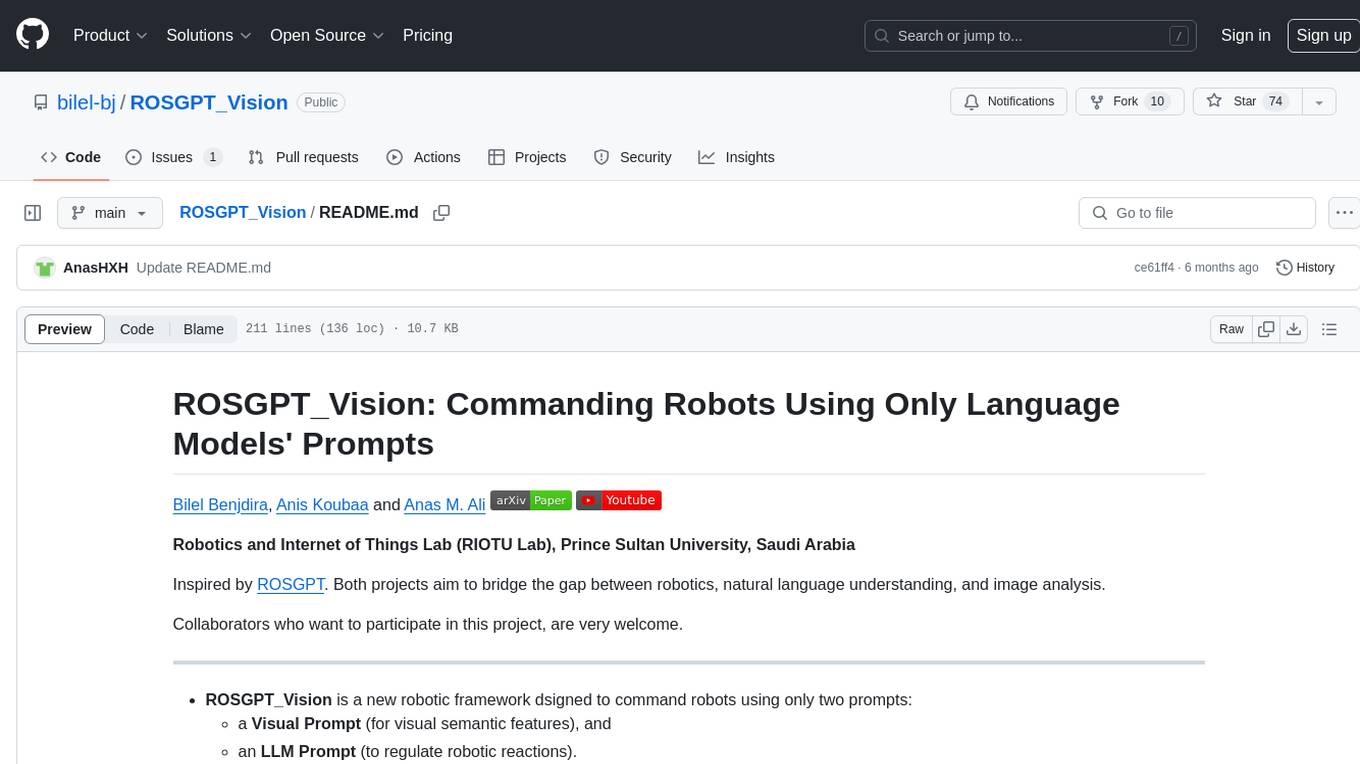
ROSGPT_Vision
ROSGPT_Vision is a new robotic framework designed to command robots using only two prompts: a Visual Prompt for visual semantic features and an LLM Prompt to regulate robotic reactions. It is based on the Prompting Robotic Modalities (PRM) design pattern and is used to develop CarMate, a robotic application for monitoring driver distractions and providing real-time vocal notifications. The framework leverages state-of-the-art language models to facilitate advanced reasoning about image data and offers a unified platform for robots to perceive, interpret, and interact with visual data through natural language. LangChain is used for easy customization of prompts, and the implementation includes the CarMate application for driver monitoring and assistance.
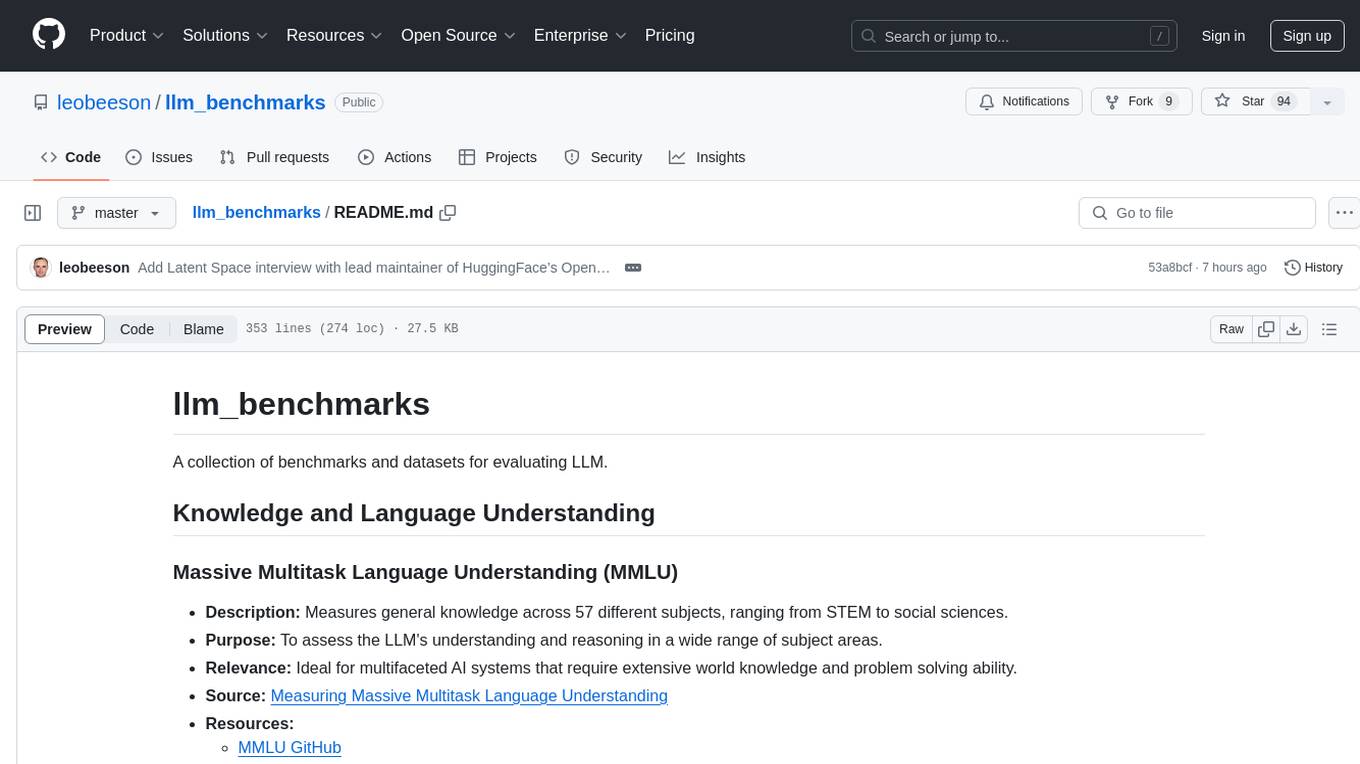
llm_benchmarks
llm_benchmarks is a collection of benchmarks and datasets for evaluating Large Language Models (LLMs). It includes various tasks and datasets to assess LLMs' knowledge, reasoning, language understanding, and conversational abilities. The repository aims to provide comprehensive evaluation resources for LLMs across different domains and applications, such as education, healthcare, content moderation, coding, and conversational AI. Researchers and developers can leverage these benchmarks to test and improve the performance of LLMs in various real-world scenarios.
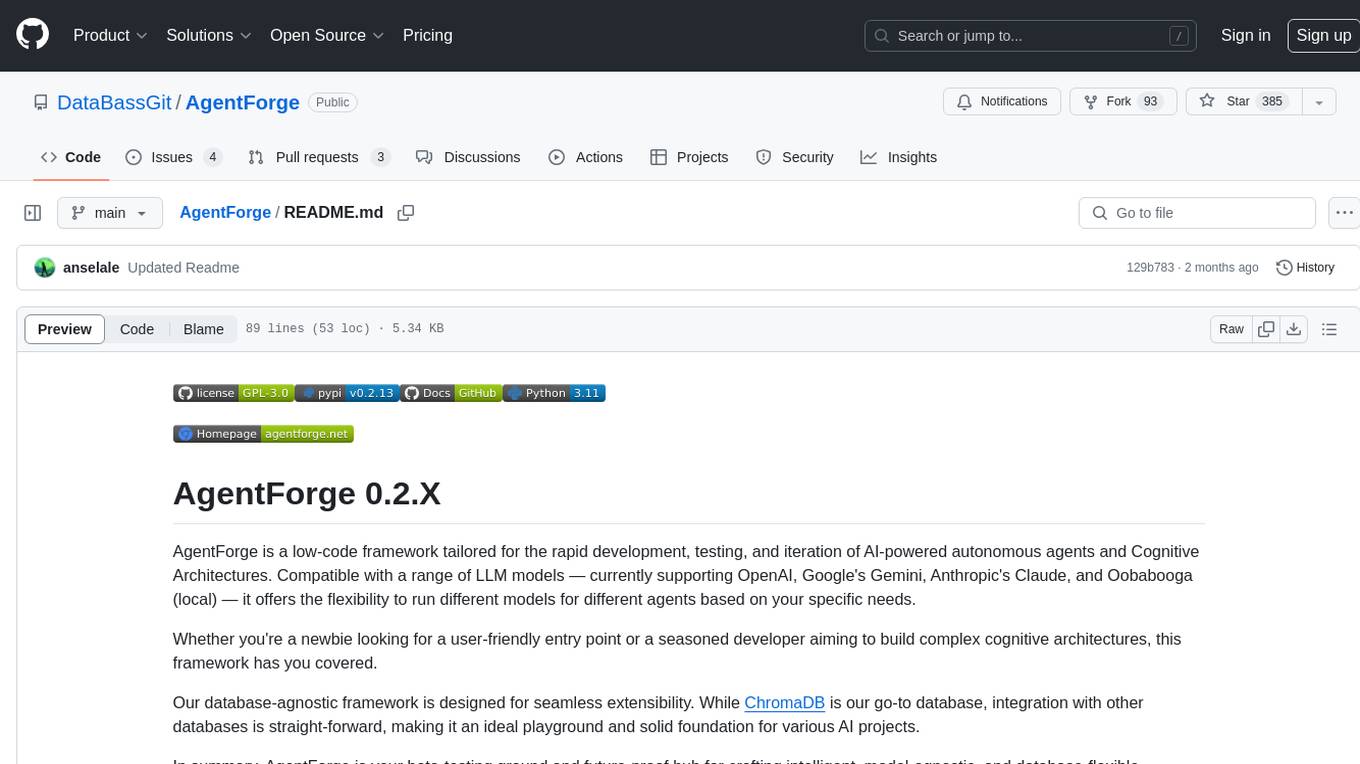
AgentForge
AgentForge is a low-code framework tailored for the rapid development, testing, and iteration of AI-powered autonomous agents and Cognitive Architectures. It is compatible with a range of LLM models and offers flexibility to run different models for different agents based on specific needs. The framework is designed for seamless extensibility and database-flexibility, making it an ideal playground for various AI projects. AgentForge is a beta-testing ground and future-proof hub for crafting intelligent, model-agnostic autonomous agents.
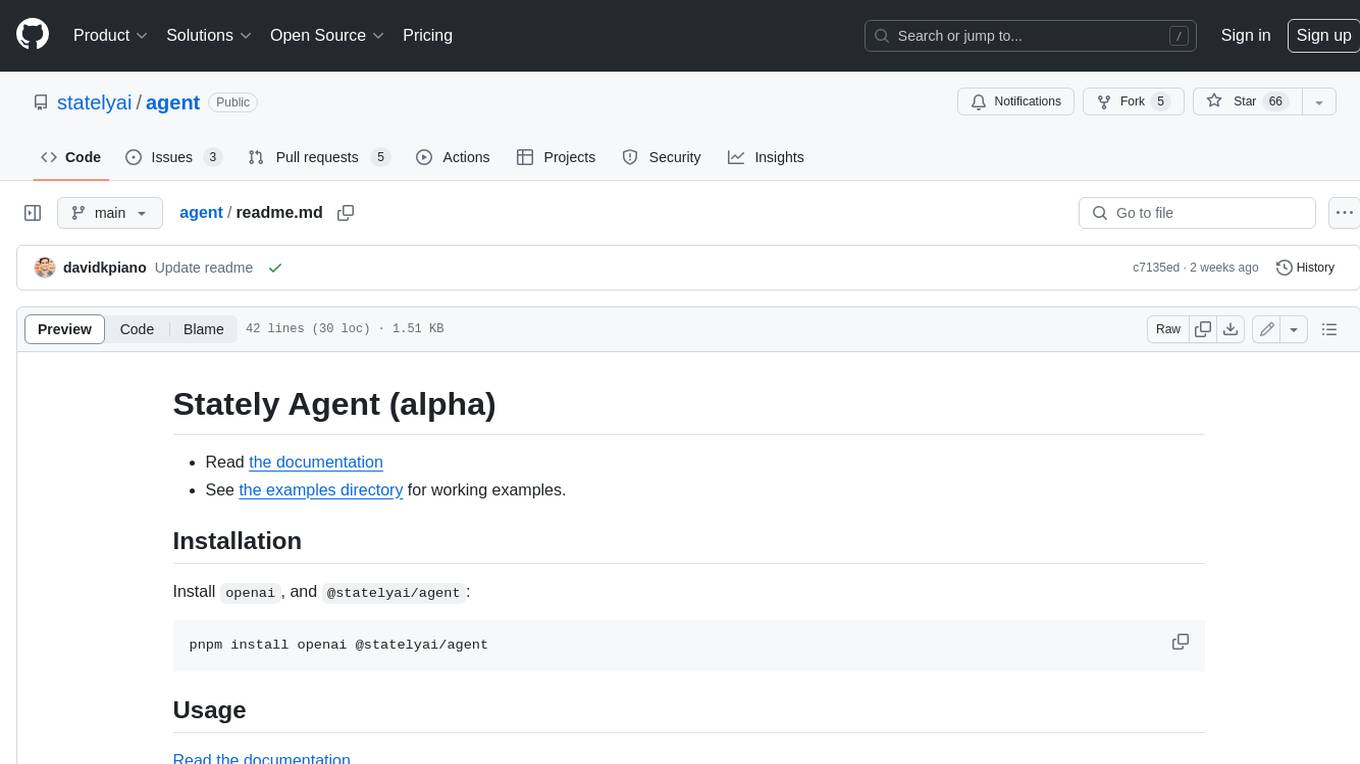
agent
Stately Agent is a library for building stateful, interactive agents using OpenAI's GPT-3 API. With Stately Agent, you can create agents that can remember past conversations, track state, and generate text that is both informative and engaging.
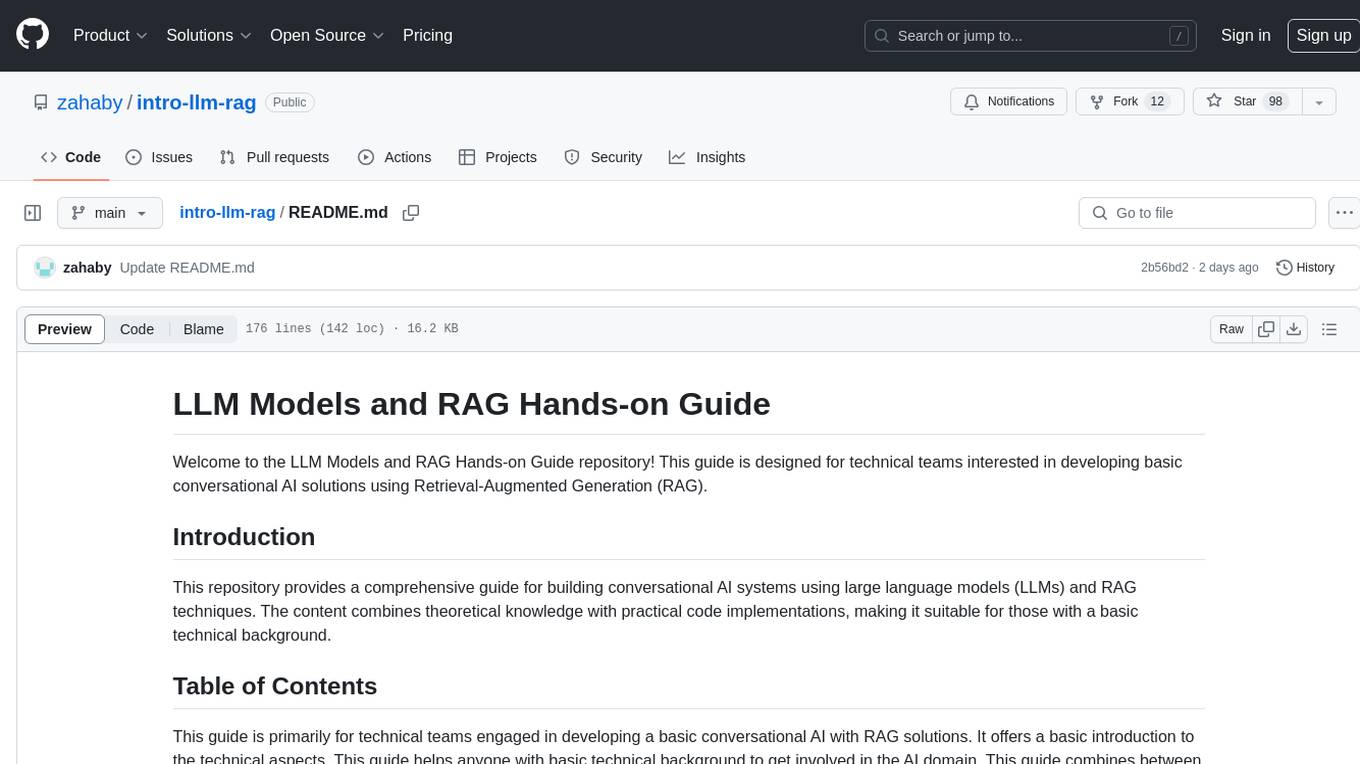
intro-llm-rag
This repository serves as a comprehensive guide for technical teams interested in developing conversational AI solutions using Retrieval-Augmented Generation (RAG) techniques. It covers theoretical knowledge and practical code implementations, making it suitable for individuals with a basic technical background. The content includes information on large language models (LLMs), transformers, prompt engineering, embeddings, vector stores, and various other key concepts related to conversational AI. The repository also provides hands-on examples for two different use cases, along with implementation details and performance analysis.
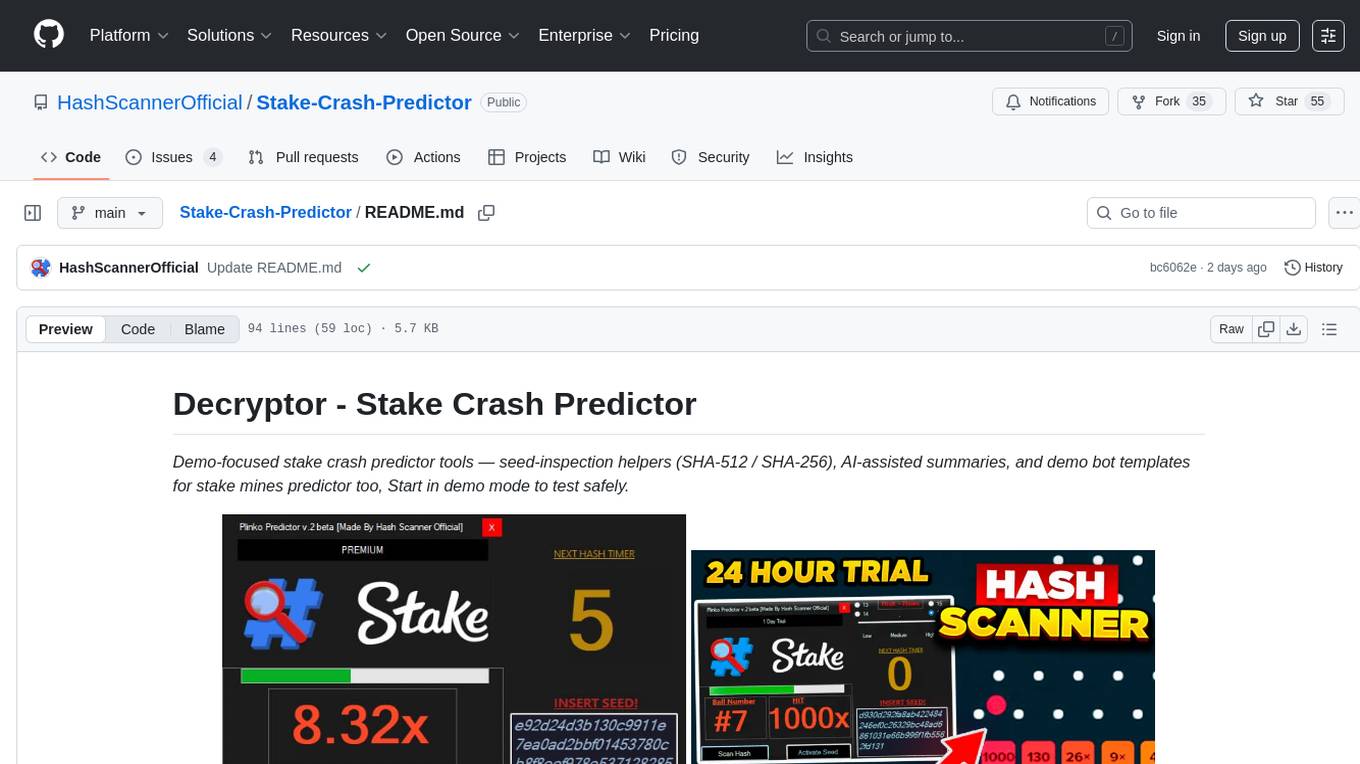
Stake-Crash-Predictor
The Stake Crash Predictor is a demo-focused toolkit that combines statistical analysis, decryption tools, and AI-assisted summaries to help users study rounds on Stake.us. It includes features like real-time prediction accuracy, AI summaries, decryption tools, and demo bot templates. Users can install the tool by downloading the ZIP file, run it in demo mode to explore crash predictor outputs, and use the server seed hash decrypt helper for educational purposes. The tool is designed for Stake.us and focuses on stake mines predictor and stake predictor workflows.
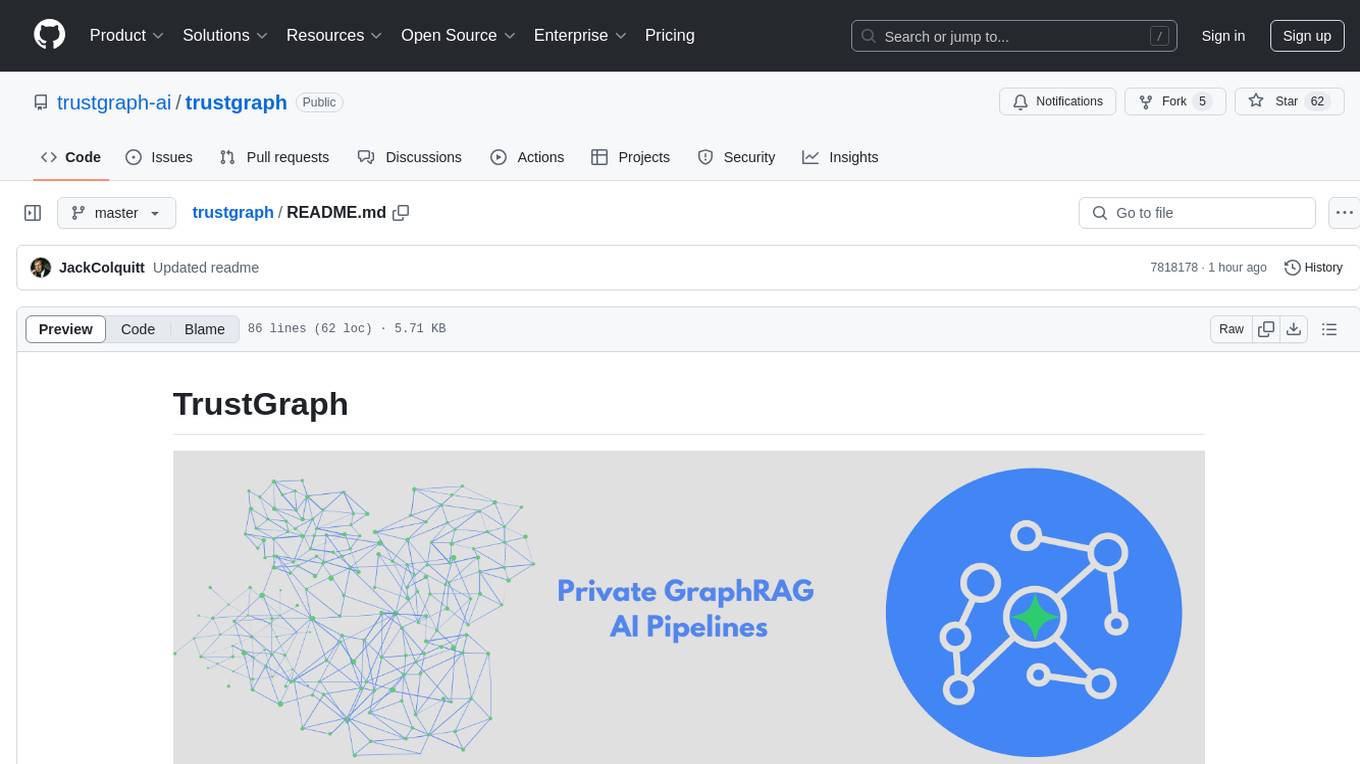
trustgraph
TrustGraph is a tool that deploys private GraphRAG pipelines to build a RDF style knowledge graph from data, enabling accurate and secure `RAG` requests compatible with cloud LLMs and open-source SLMs. It showcases the reliability and efficiencies of GraphRAG algorithms, capturing contextual language flags missed in conventional RAG approaches. The tool offers features like PDF decoding, text chunking, inference of various LMs, RDF-aligned Knowledge Graph extraction, and more. TrustGraph is designed to be modular, supporting multiple Language Models and environments, with a plug'n'play architecture for easy customization.
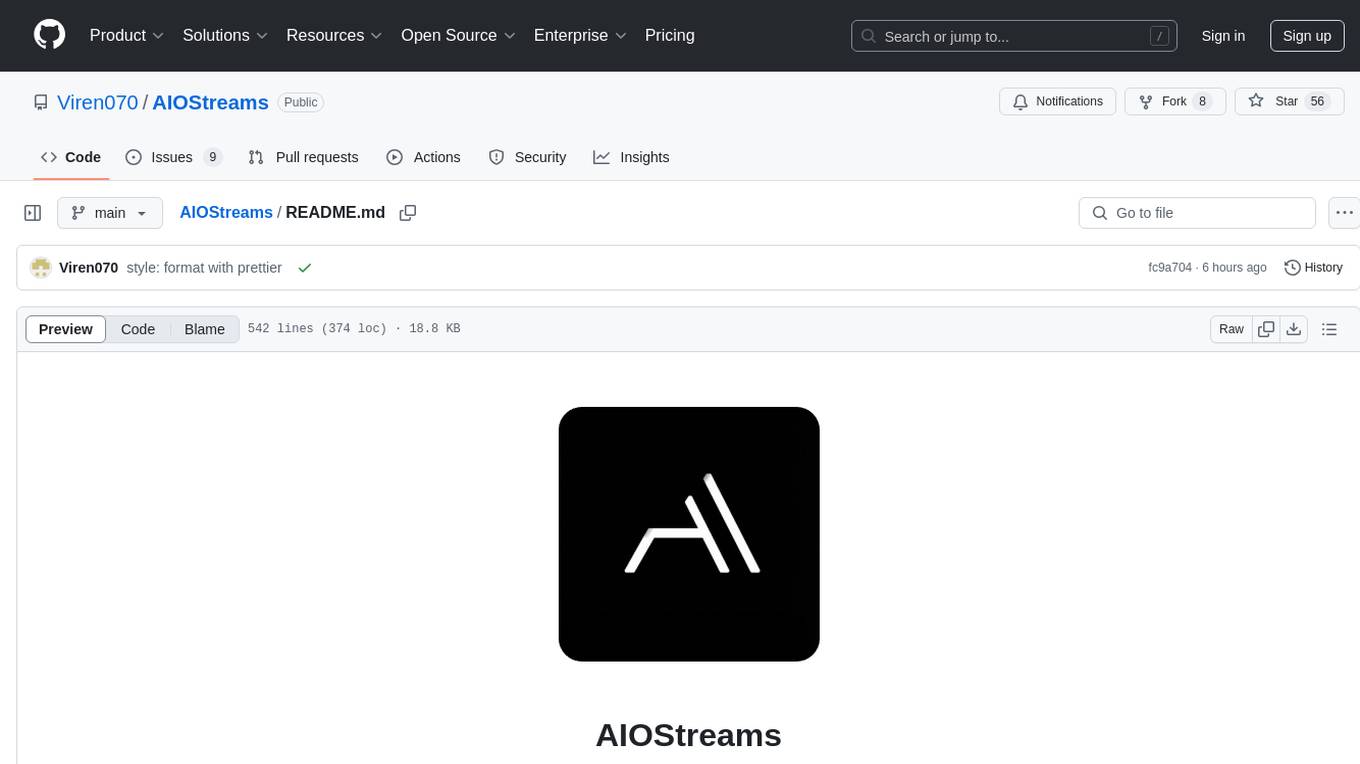
AIOStreams
AIOStreams is a versatile tool that combines streams from various addons into one platform, offering extensive customization options. Users can change result formats, filter results by various criteria, remove duplicates, prioritize services, sort results, specify size limits, and more. The tool scrapes results from selected addons, applies user configurations, and presents the results in a unified manner. It simplifies the process of finding and accessing desired content from multiple sources, enhancing user experience and efficiency.
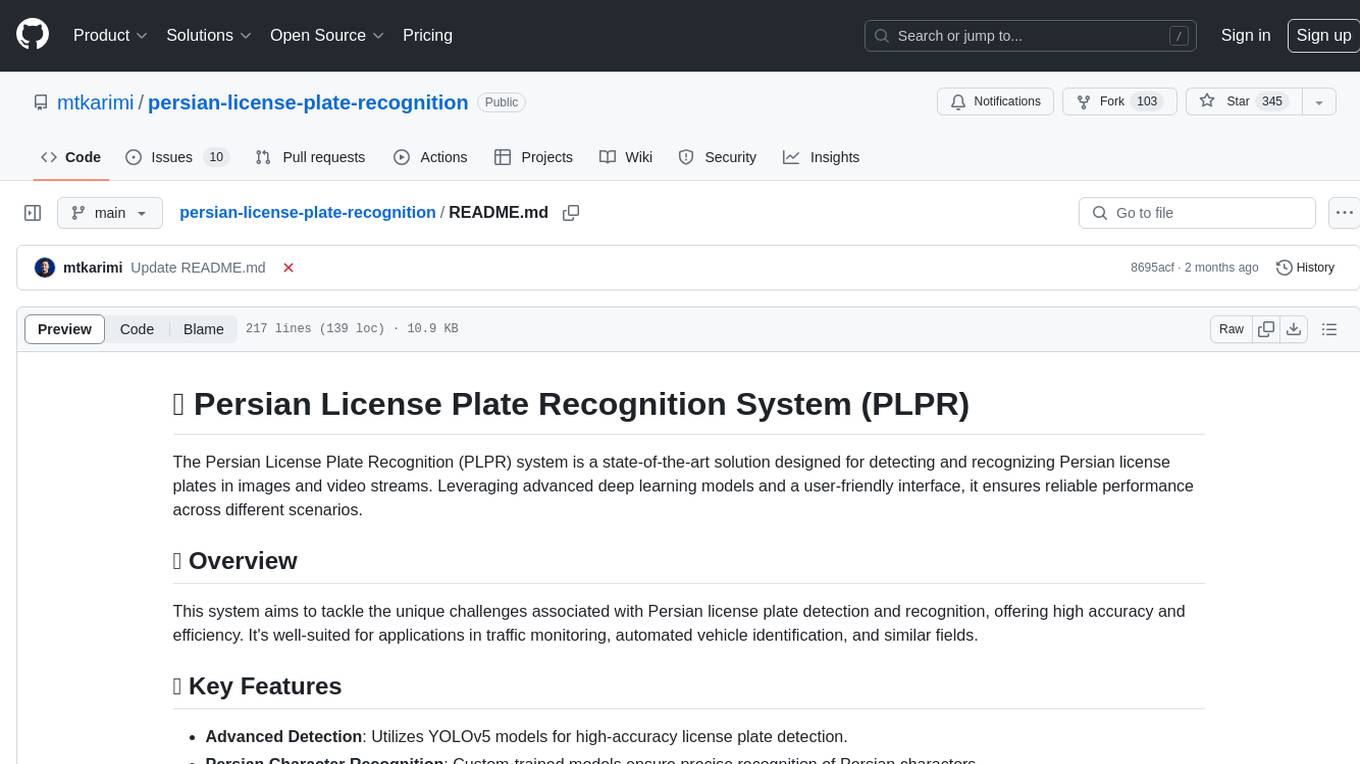
persian-license-plate-recognition
The Persian License Plate Recognition (PLPR) system is a state-of-the-art solution designed for detecting and recognizing Persian license plates in images and video streams. Leveraging advanced deep learning models and a user-friendly interface, it ensures reliable performance across different scenarios. The system offers advanced detection using YOLOv5 models, precise recognition of Persian characters, real-time processing capabilities, and a user-friendly GUI. It is well-suited for applications in traffic monitoring, automated vehicle identification, and similar fields. The system's architecture includes modules for resident management, entrance management, and a detailed flowchart explaining the process from system initialization to displaying results in the GUI. Hardware requirements include an Intel Core i5 processor, 8 GB RAM, a dedicated GPU with at least 4 GB VRAM, and an SSD with 20 GB of free space. The system can be installed by cloning the repository and installing required Python packages. Users can customize the video source for processing and run the application to upload and process images or video streams. The system's GUI allows for parameter adjustments to optimize performance, and the Wiki provides in-depth information on the system's architecture and model training.
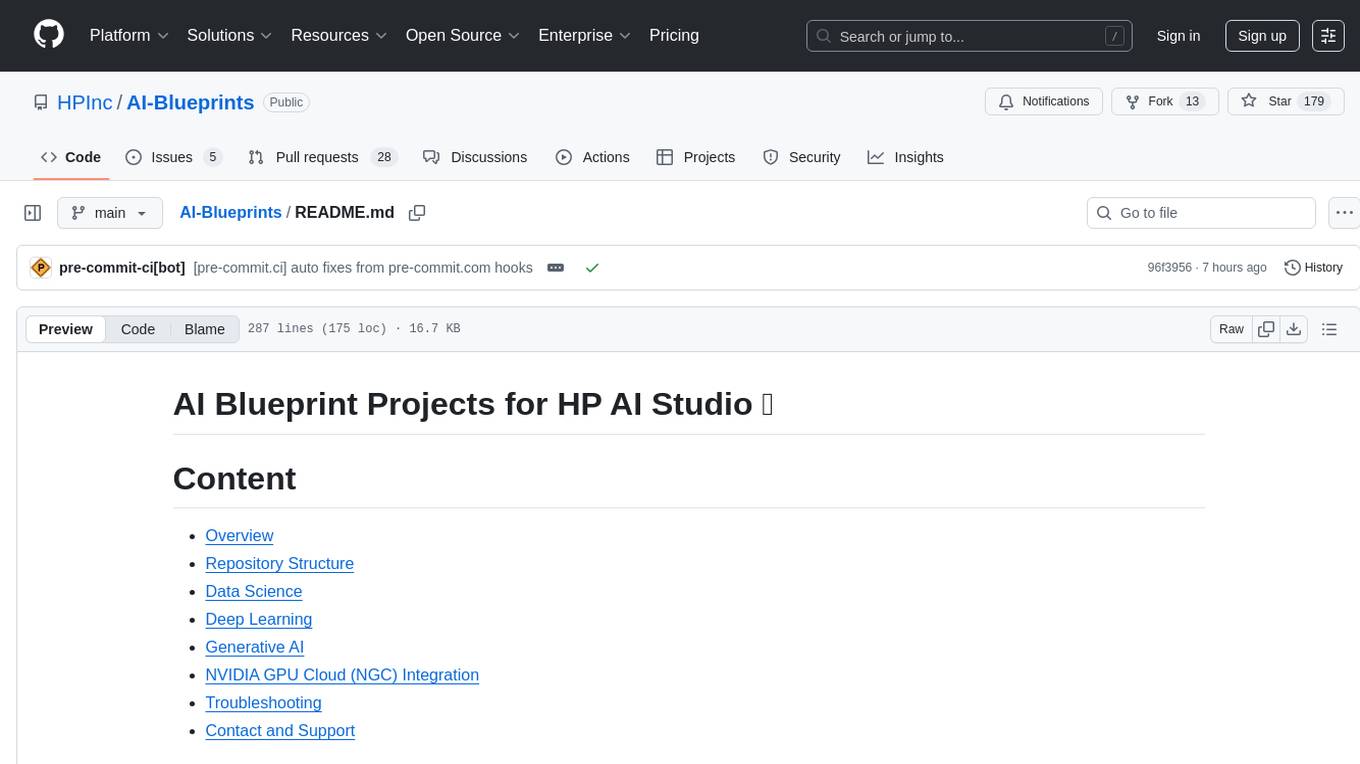
AI-Blueprints
This repository hosts a collection of AI blueprint projects for HP AI Studio, providing end-to-end solutions across key AI domains like data science, machine learning, deep learning, and generative AI. The projects are designed to be plug-and-play, utilizing open-source and hosted models to offer ready-to-use solutions. The repository structure includes projects related to classical machine learning, deep learning applications, generative AI, NGC integration, and troubleshooting guidelines for common issues. Each project is accompanied by detailed descriptions and use cases, showcasing the versatility and applicability of AI technologies in various domains.
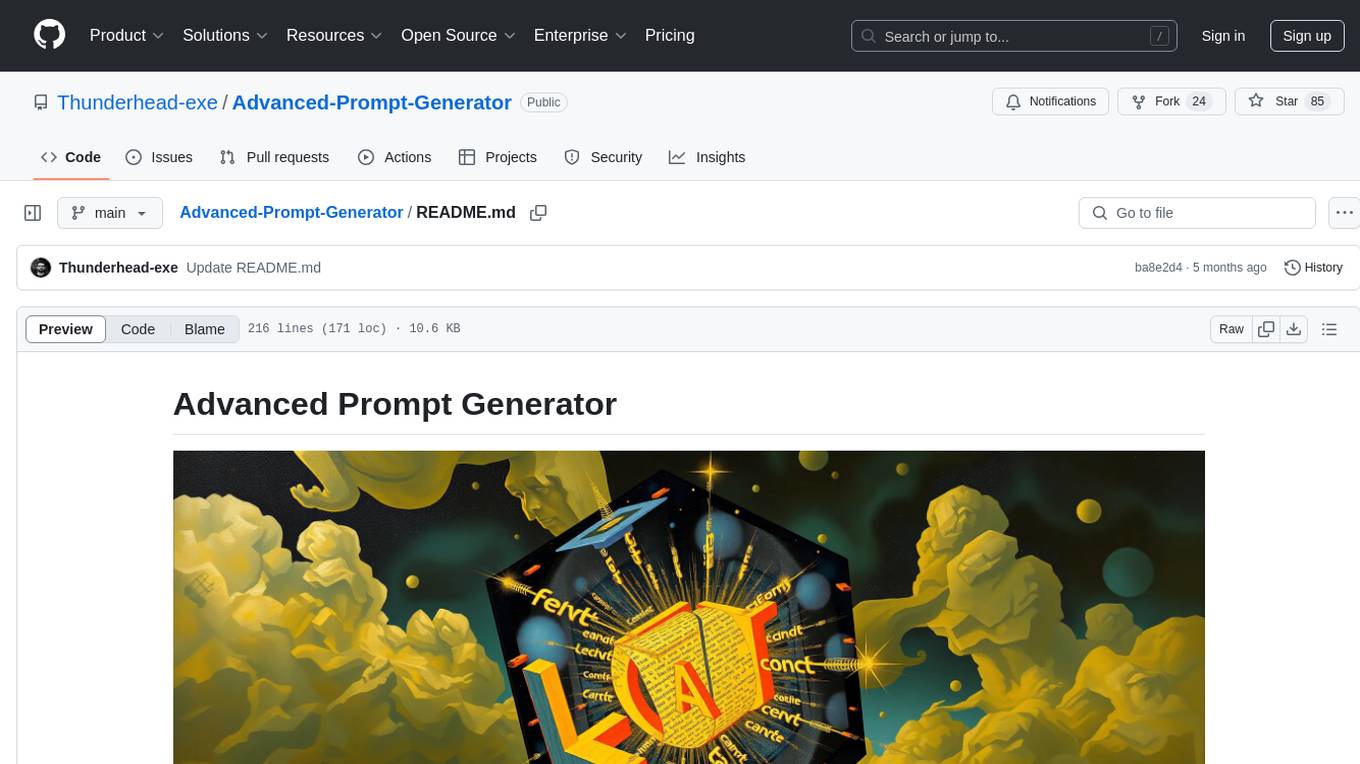
Advanced-Prompt-Generator
This project is an LLM-based Advanced Prompt Generator designed to automate the process of prompt engineering by enhancing given input prompts using large language models (LLMs). The tool can generate advanced prompts with minimal user input, leveraging LLM agents for optimized prompt generation. It supports gpt-4o or gpt-4o-mini, offers FastAPI & Docker deployment for efficiency, provides a Gradio interface for easy testing, and is hosted on Hugging Face Spaces for quick demos. Users can expand model support to offer more variety and flexibility.
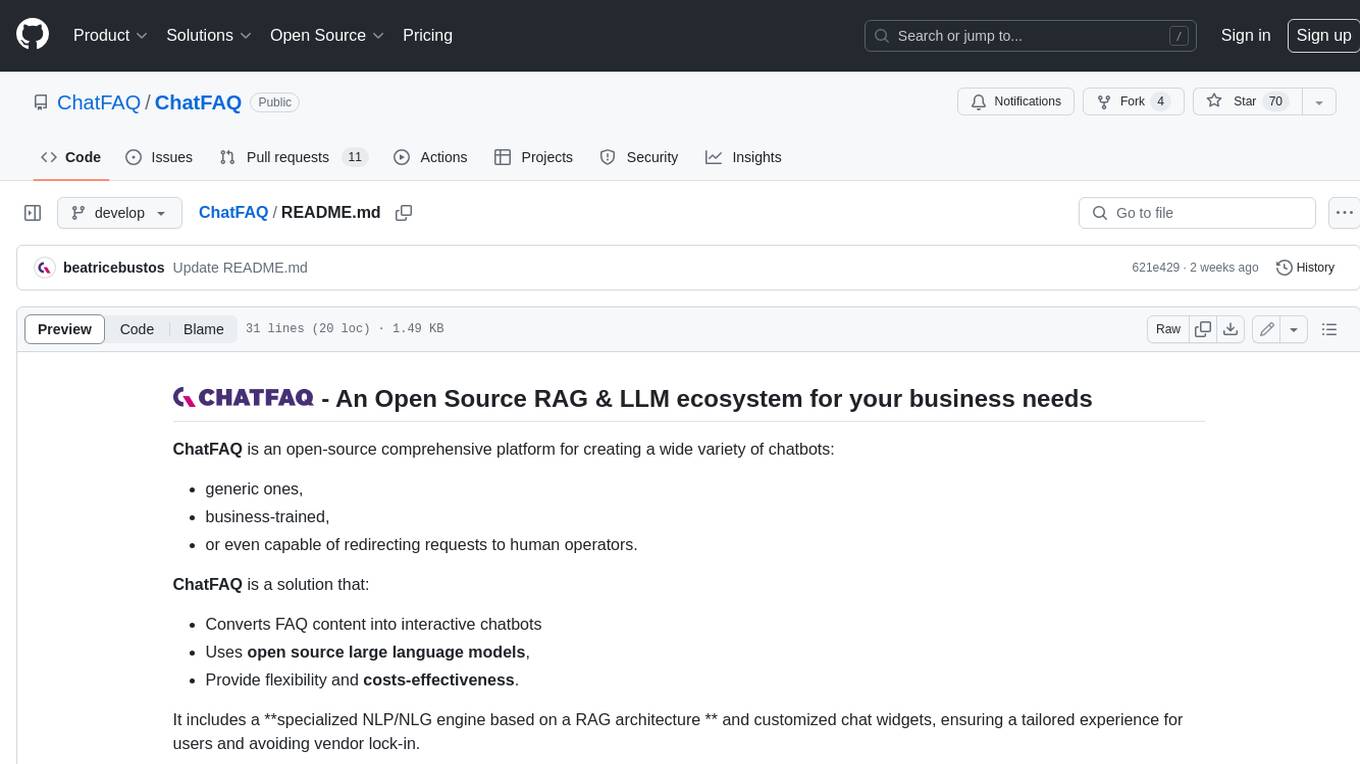
ChatFAQ
ChatFAQ is an open-source comprehensive platform for creating a wide variety of chatbots: generic ones, business-trained, or even capable of redirecting requests to human operators. It includes a specialized NLP/NLG engine based on a RAG architecture and customized chat widgets, ensuring a tailored experience for users and avoiding vendor lock-in.
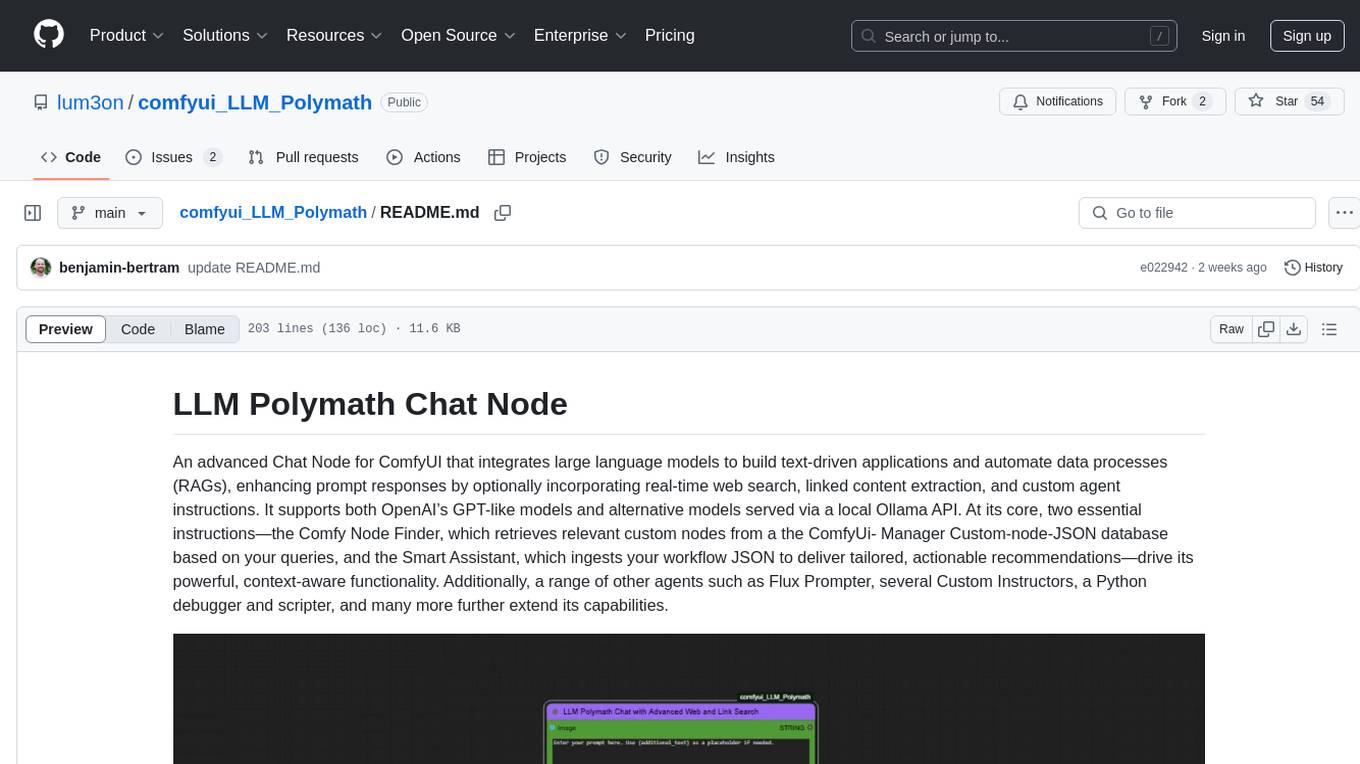
comfyui_LLM_Polymath
LLM Polymath Chat Node is an advanced Chat Node for ComfyUI that integrates large language models to build text-driven applications and automate data processes, enhancing prompt responses by incorporating real-time web search, linked content extraction, and custom agent instructions. It supports both OpenAI’s GPT-like models and alternative models served via a local Ollama API. The core functionalities include Comfy Node Finder and Smart Assistant, along with additional agents like Flux Prompter, Custom Instructors, Python debugger, and scripter. The tool offers features for prompt processing, web search integration, model & API integration, custom instructions, image handling, logging & debugging, output compression, and more.
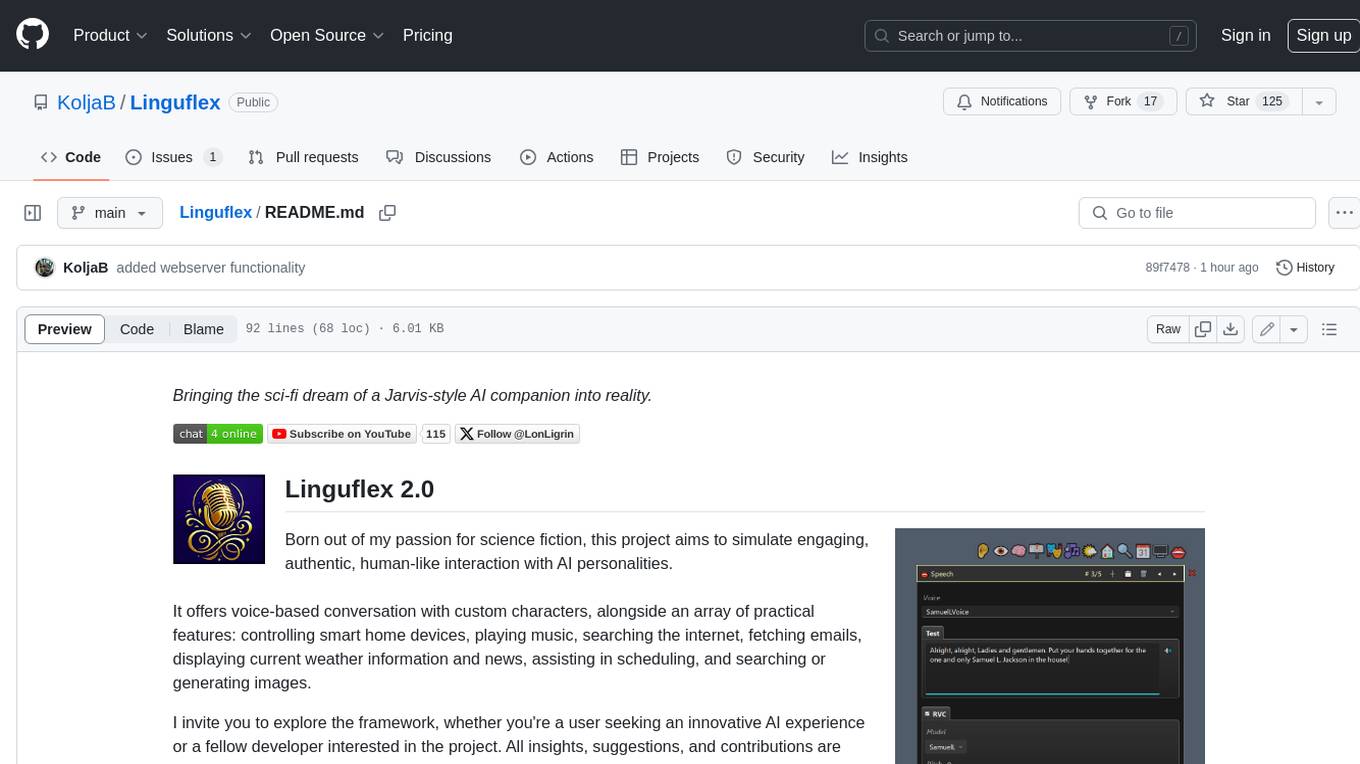
Linguflex
Linguflex is a project that aims to simulate engaging, authentic, human-like interaction with AI personalities. It offers voice-based conversation with custom characters, alongside an array of practical features such as controlling smart home devices, playing music, searching the internet, fetching emails, displaying current weather information and news, assisting in scheduling, and searching or generating images.
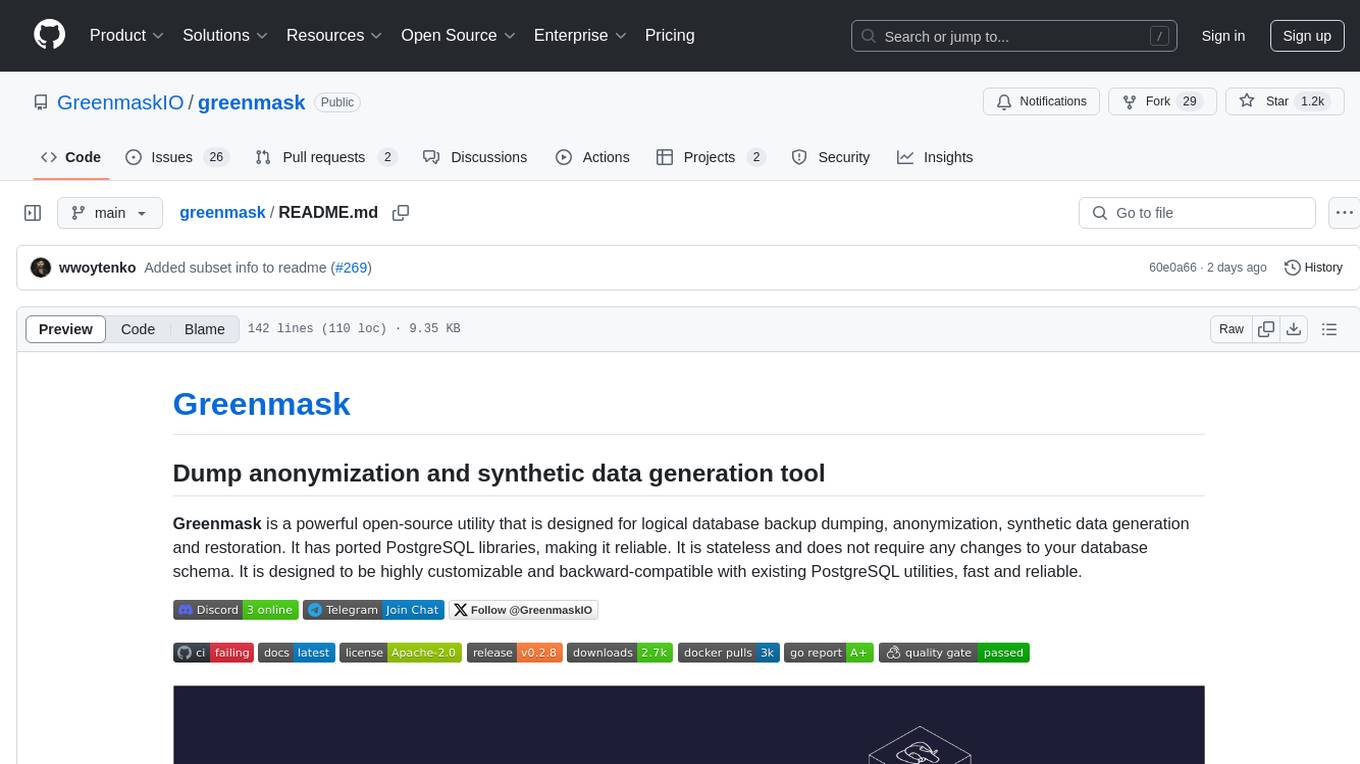
greenmask
Greenmask is a powerful open-source utility designed for logical database backup dumping, anonymization, synthetic data generation, and restoration. It is highly customizable, stateless, and backward-compatible with existing PostgreSQL utilities. Greenmask supports advanced subset systems, deterministic transformers, dynamic parameters, transformation conditions, and more. It is cross-platform, database type safe, extensible, and supports parallel execution and various storage options. Ideal for backup and restoration tasks, anonymization, transformation, and data masking.
For similar tasks

ai-notes
Notes on AI state of the art, with a focus on generative and large language models. These are the "raw materials" for the https://lspace.swyx.io/ newsletter. This repo used to be called https://github.com/sw-yx/prompt-eng, but was renamed because Prompt Engineering is Overhyped. This is now an AI Engineering notes repo.
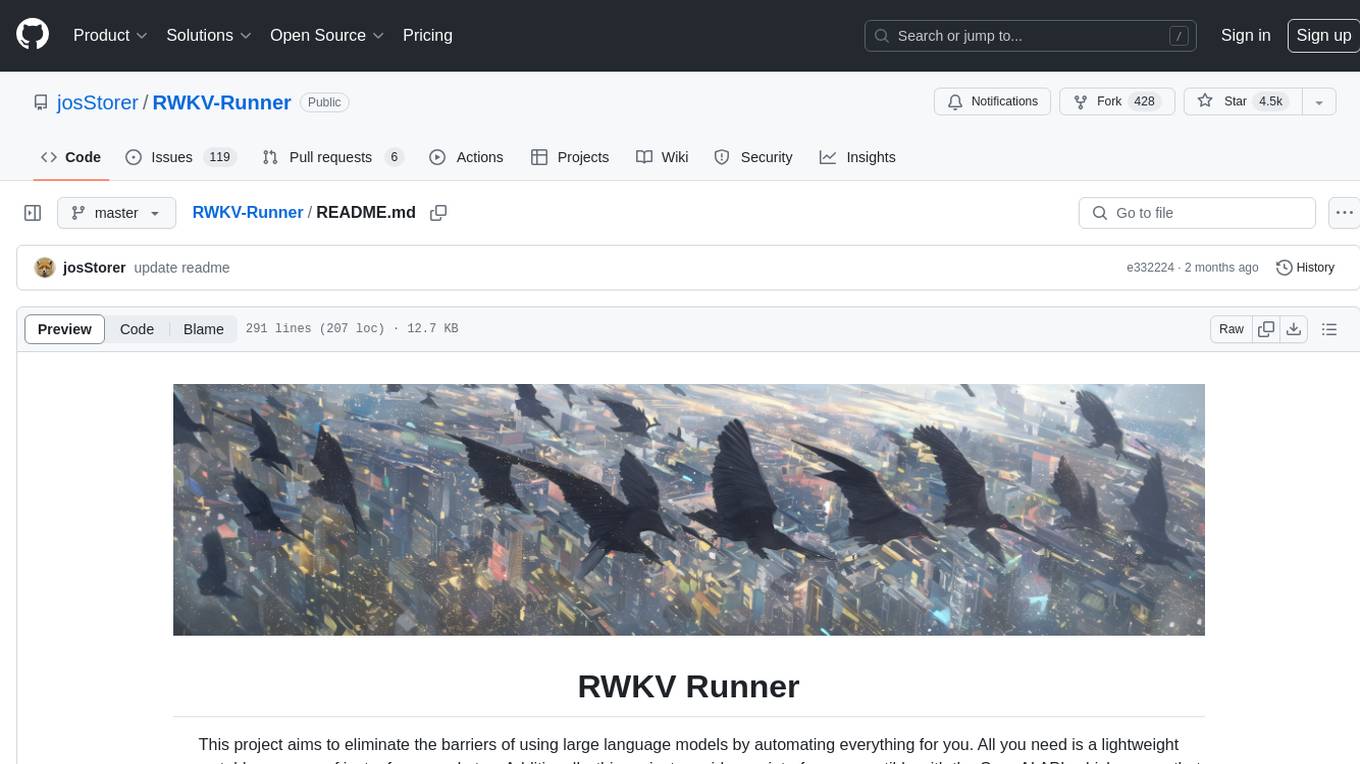
RWKV-Runner
RWKV Runner is a project designed to simplify the usage of large language models by automating various processes. It provides a lightweight executable program and is compatible with the OpenAI API. Users can deploy the backend on a server and use the program as a client. The project offers features like model management, VRAM configurations, user-friendly chat interface, WebUI option, parameter configuration, model conversion tool, download management, LoRA Finetune, and multilingual localization. It can be used for various tasks such as chat, completion, composition, and model inspection.
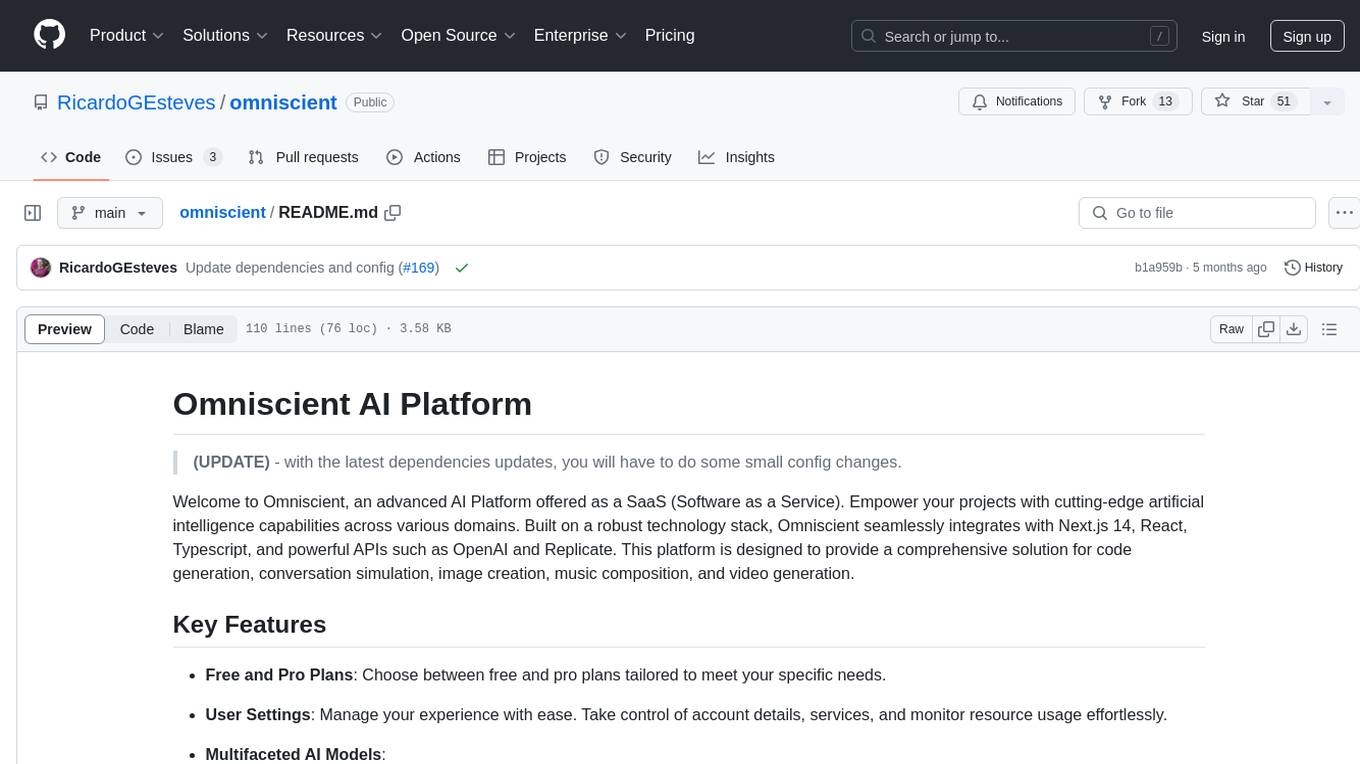
omniscient
Omniscient is an advanced AI Platform offered as a SaaS, empowering projects with cutting-edge artificial intelligence capabilities. Seamlessly integrating with Next.js 14, React, Typescript, and APIs like OpenAI and Replicate, it provides solutions for code generation, conversation simulation, image creation, music composition, and video generation.
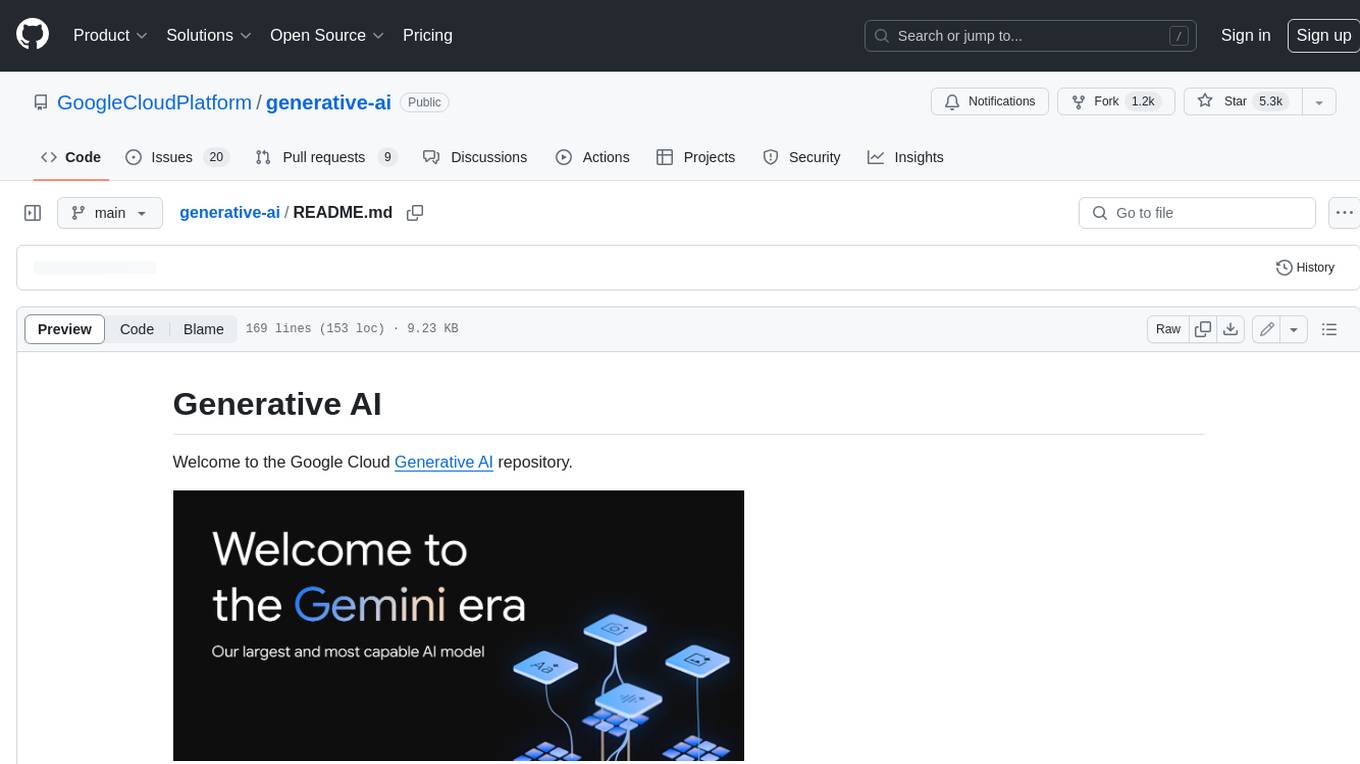
generative-ai
This repository contains notebooks, code samples, sample apps, and other resources that demonstrate how to use, develop and manage generative AI workflows using Generative AI on Google Cloud, powered by Vertex AI. For more Vertex AI samples, please visit the Vertex AI samples Github repository.
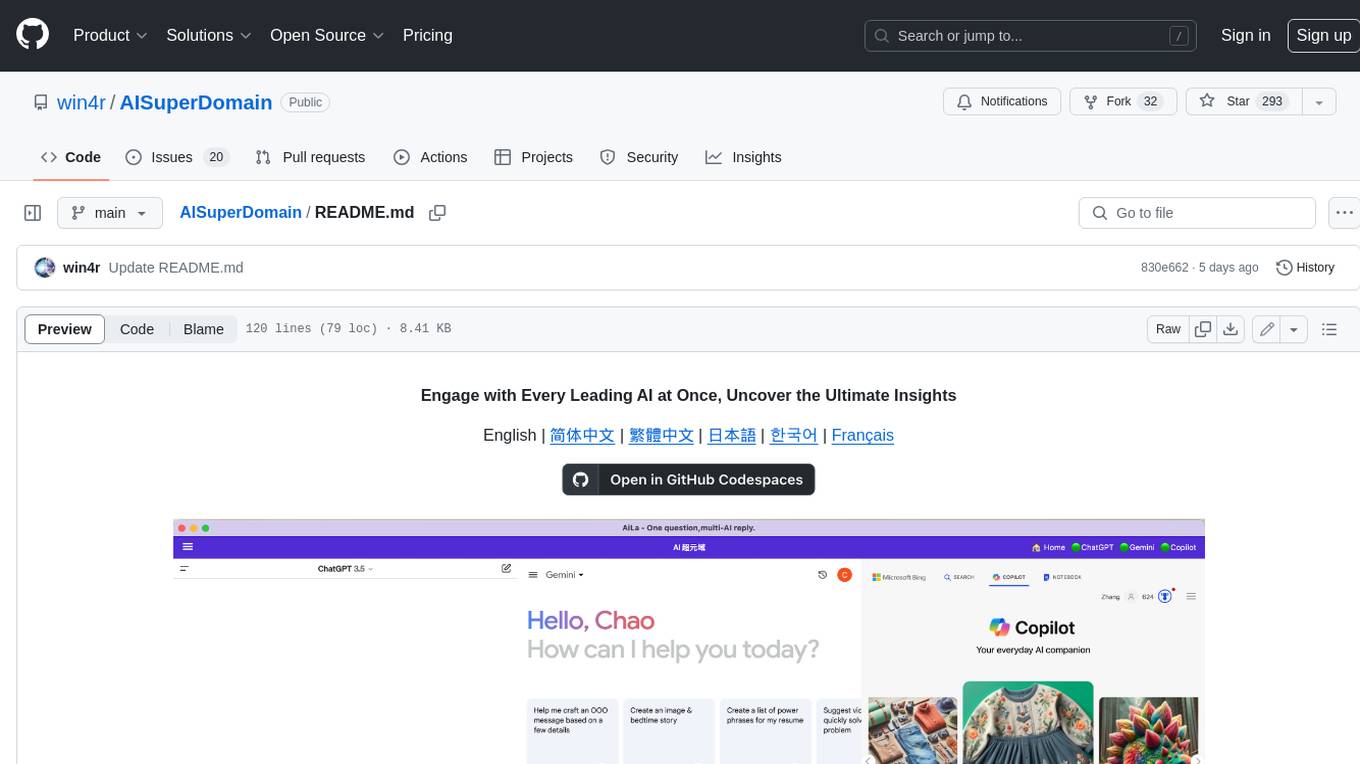
AISuperDomain
Aila Desktop Application is a powerful tool that integrates multiple leading AI models into a single desktop application. It allows users to interact with various AI models simultaneously, providing diverse responses and insights to their inquiries. With its user-friendly interface and customizable features, Aila empowers users to engage with AI seamlessly and efficiently. Whether you're a researcher, student, or professional, Aila can enhance your AI interactions and streamline your workflow.
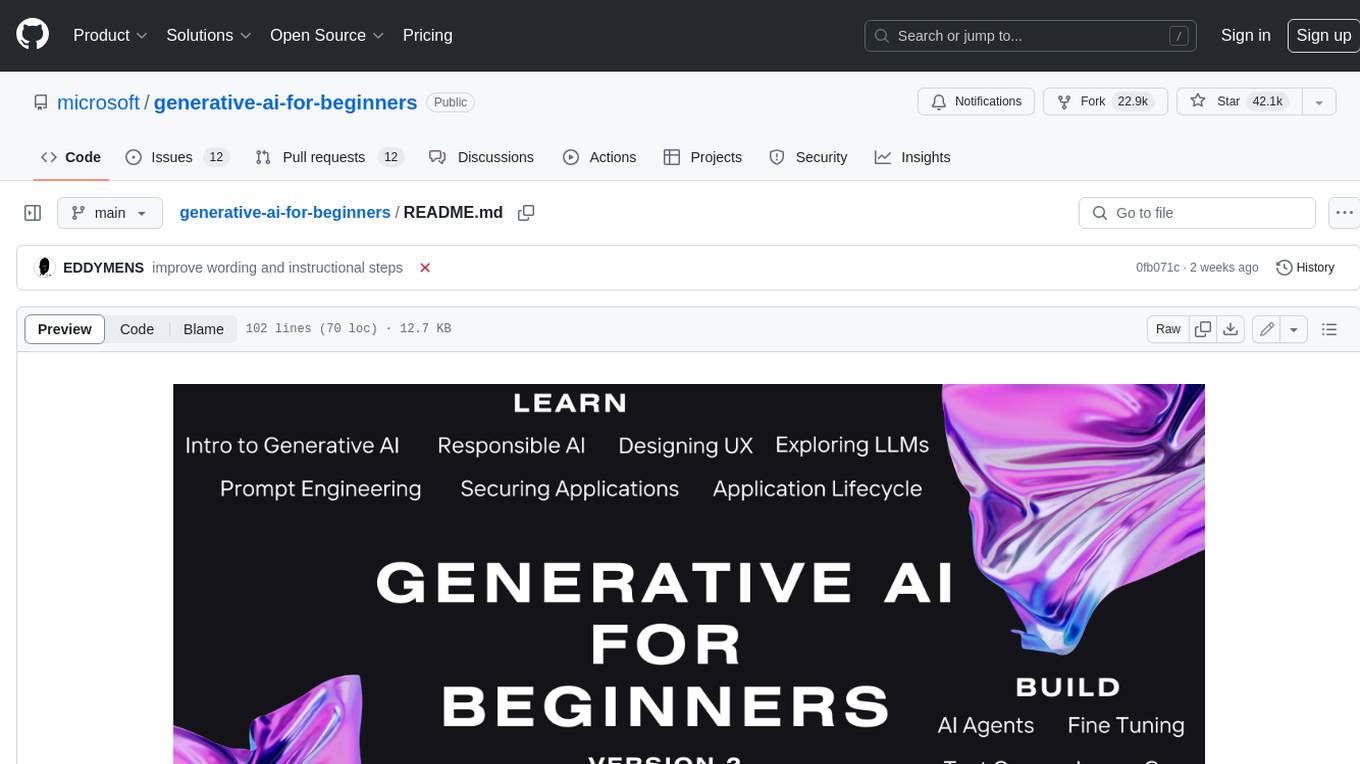
generative-ai-for-beginners
This course has 18 lessons. Each lesson covers its own topic so start wherever you like! Lessons are labeled either "Learn" lessons explaining a Generative AI concept or "Build" lessons that explain a concept and code examples in both **Python** and **TypeScript** when possible. Each lesson also includes a "Keep Learning" section with additional learning tools. **What You Need** * Access to the Azure OpenAI Service **OR** OpenAI API - _Only required to complete coding lessons_ * Basic knowledge of Python or Typescript is helpful - *For absolute beginners check out these Python and TypeScript courses. * A Github account to fork this entire repo to your own GitHub account We have created a **Course Setup** lesson to help you with setting up your development environment. Don't forget to star (🌟) this repo to find it easier later. ## 🧠 Ready to Deploy? If you are looking for more advanced code samples, check out our collection of Generative AI Code Samples in both **Python** and **TypeScript**. ## 🗣️ Meet Other Learners, Get Support Join our official AI Discord server to meet and network with other learners taking this course and get support. ## 🚀 Building a Startup? Sign up for Microsoft for Startups Founders Hub to receive **free OpenAI credits** and up to **$150k towards Azure credits to access OpenAI models through Azure OpenAI Services**. ## 🙏 Want to help? Do you have suggestions or found spelling or code errors? Raise an issue or Create a pull request ## 📂 Each lesson includes: * A short video introduction to the topic * A written lesson located in the README * Python and TypeScript code samples supporting Azure OpenAI and OpenAI API * Links to extra resources to continue your learning ## 🗃️ Lessons | | Lesson Link | Description | Additional Learning | | :-: | :------------------------------------------------------------------------------------------------------------------------------------------: | :---------------------------------------------------------------------------------------------: | ------------------------------------------------------------------------------ | | 00 | Course Setup | **Learn:** How to Setup Your Development Environment | Learn More | | 01 | Introduction to Generative AI and LLMs | **Learn:** Understanding what Generative AI is and how Large Language Models (LLMs) work. | Learn More | | 02 | Exploring and comparing different LLMs | **Learn:** How to select the right model for your use case | Learn More | | 03 | Using Generative AI Responsibly | **Learn:** How to build Generative AI Applications responsibly | Learn More | | 04 | Understanding Prompt Engineering Fundamentals | **Learn:** Hands-on Prompt Engineering Best Practices | Learn More | | 05 | Creating Advanced Prompts | **Learn:** How to apply prompt engineering techniques that improve the outcome of your prompts. | Learn More | | 06 | Building Text Generation Applications | **Build:** A text generation app using Azure OpenAI | Learn More | | 07 | Building Chat Applications | **Build:** Techniques for efficiently building and integrating chat applications. | Learn More | | 08 | Building Search Apps Vector Databases | **Build:** A search application that uses Embeddings to search for data. | Learn More | | 09 | Building Image Generation Applications | **Build:** A image generation application | Learn More | | 10 | Building Low Code AI Applications | **Build:** A Generative AI application using Low Code tools | Learn More | | 11 | Integrating External Applications with Function Calling | **Build:** What is function calling and its use cases for applications | Learn More | | 12 | Designing UX for AI Applications | **Learn:** How to apply UX design principles when developing Generative AI Applications | Learn More | | 13 | Securing Your Generative AI Applications | **Learn:** The threats and risks to AI systems and methods to secure these systems. | Learn More | | 14 | The Generative AI Application Lifecycle | **Learn:** The tools and metrics to manage the LLM Lifecycle and LLMOps | Learn More | | 15 | Retrieval Augmented Generation (RAG) and Vector Databases | **Build:** An application using a RAG Framework to retrieve embeddings from a Vector Databases | Learn More | | 16 | Open Source Models and Hugging Face | **Build:** An application using open source models available on Hugging Face | Learn More | | 17 | AI Agents | **Build:** An application using an AI Agent Framework | Learn More | | 18 | Fine-Tuning LLMs | **Learn:** The what, why and how of fine-tuning LLMs | Learn More |
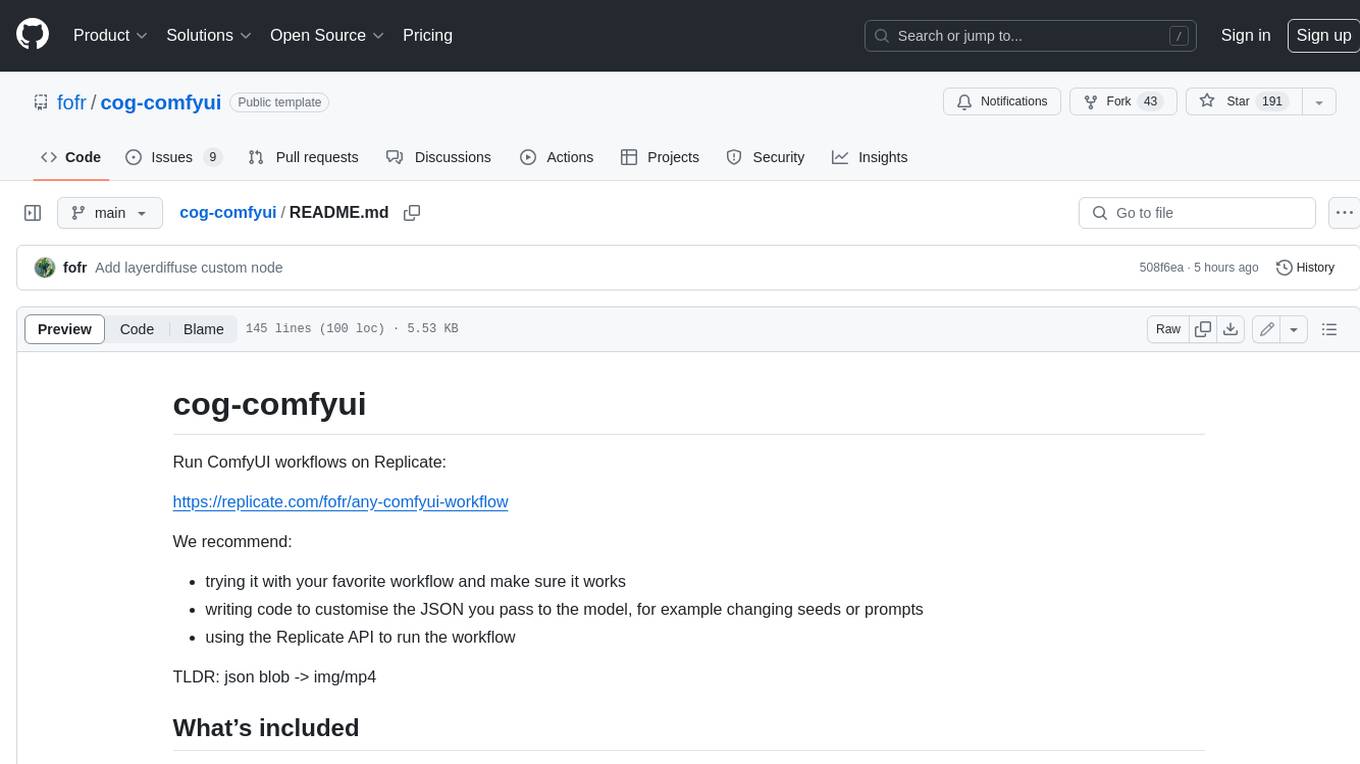
cog-comfyui
Cog-comfyui allows users to run ComfyUI workflows on Replicate. ComfyUI is a visual programming tool for creating and sharing generative art workflows. With cog-comfyui, users can access a variety of pre-trained models and custom nodes to create their own unique artworks. The tool is easy to use and does not require any coding experience. Users simply need to upload their API JSON file and any necessary input files, and then click the "Run" button. Cog-comfyui will then generate the output image or video file.
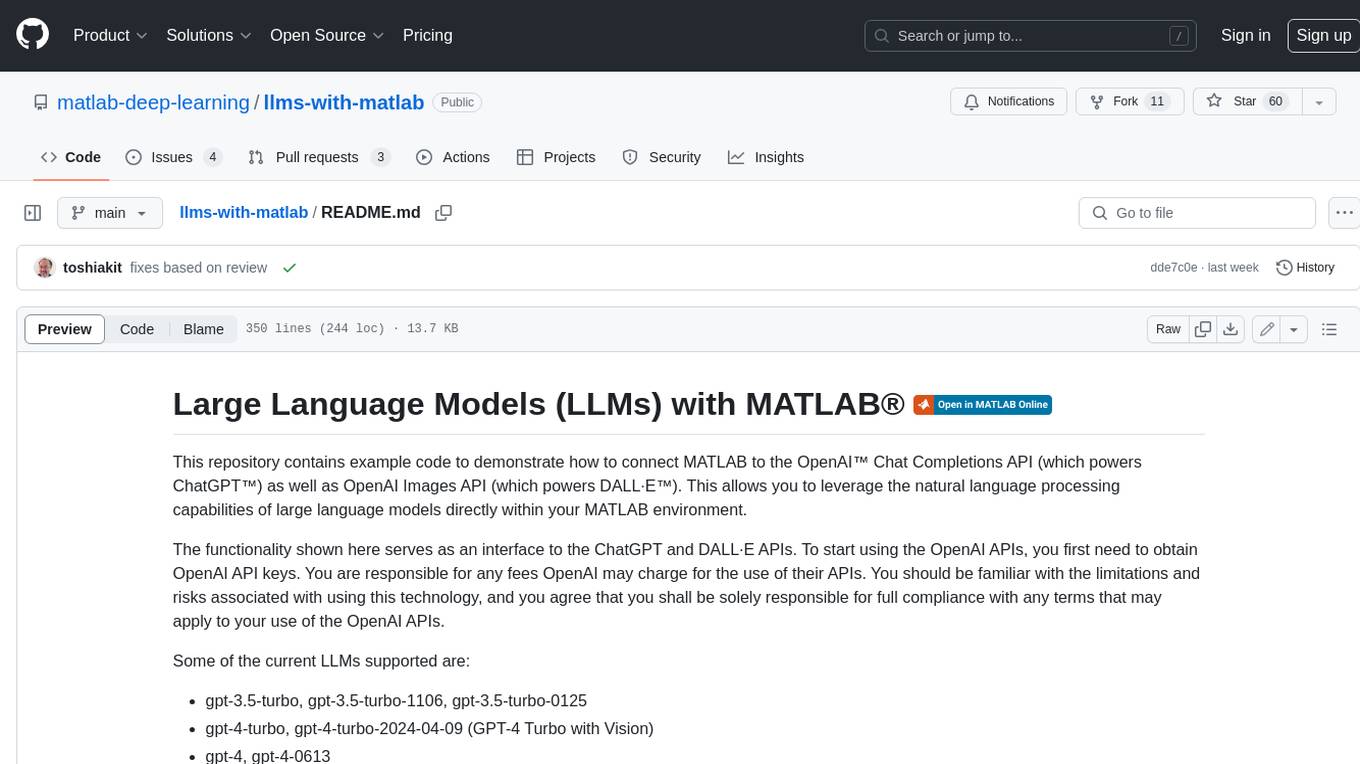
llms-with-matlab
This repository contains example code to demonstrate how to connect MATLAB to the OpenAI™ Chat Completions API (which powers ChatGPT™) as well as OpenAI Images API (which powers DALL·E™). This allows you to leverage the natural language processing capabilities of large language models directly within your MATLAB environment.
For similar jobs
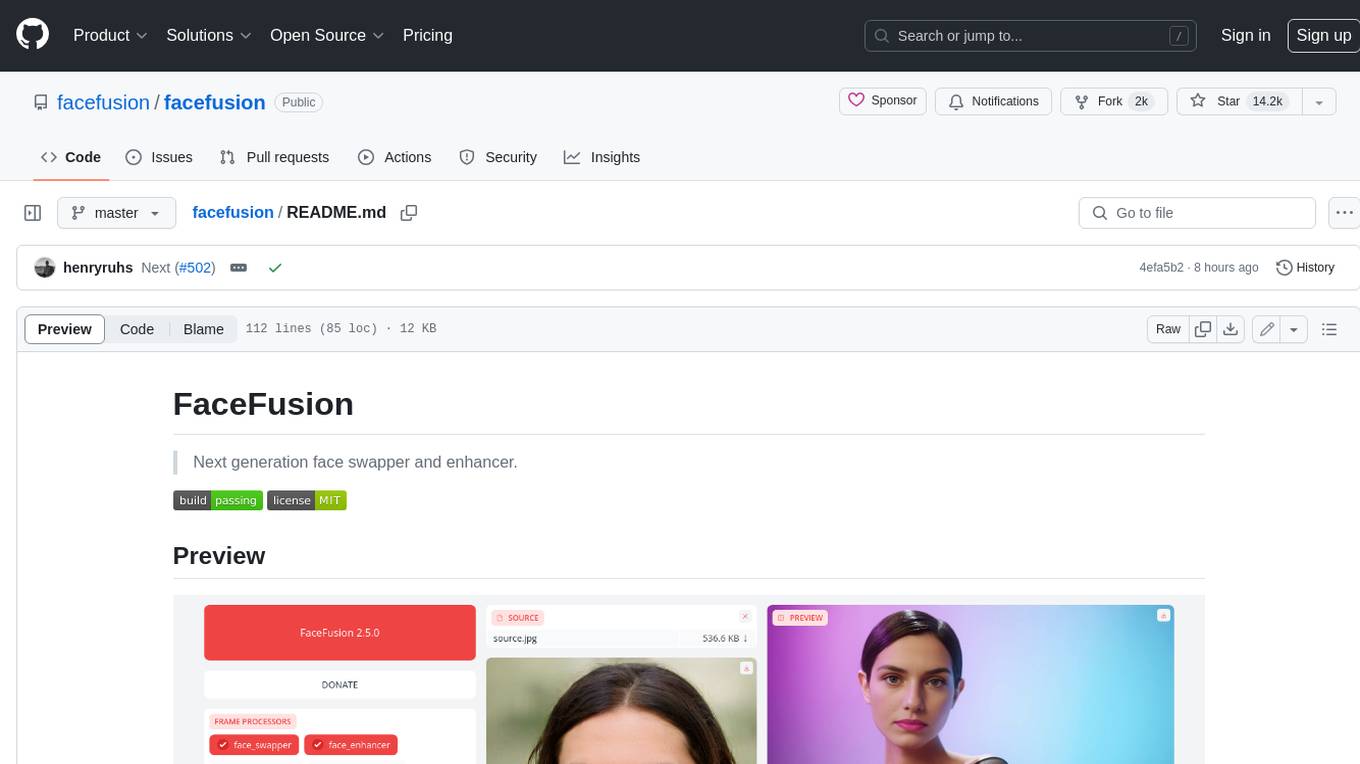
facefusion
FaceFusion is a next-generation face swapper and enhancer that allows users to seamlessly swap faces in images and videos, as well as enhance facial features for a more polished and refined look. With its advanced deep learning models, FaceFusion provides users with a wide range of options for customizing their face swaps and enhancements, making it an ideal tool for content creators, artists, and anyone looking to explore their creativity with facial manipulation.
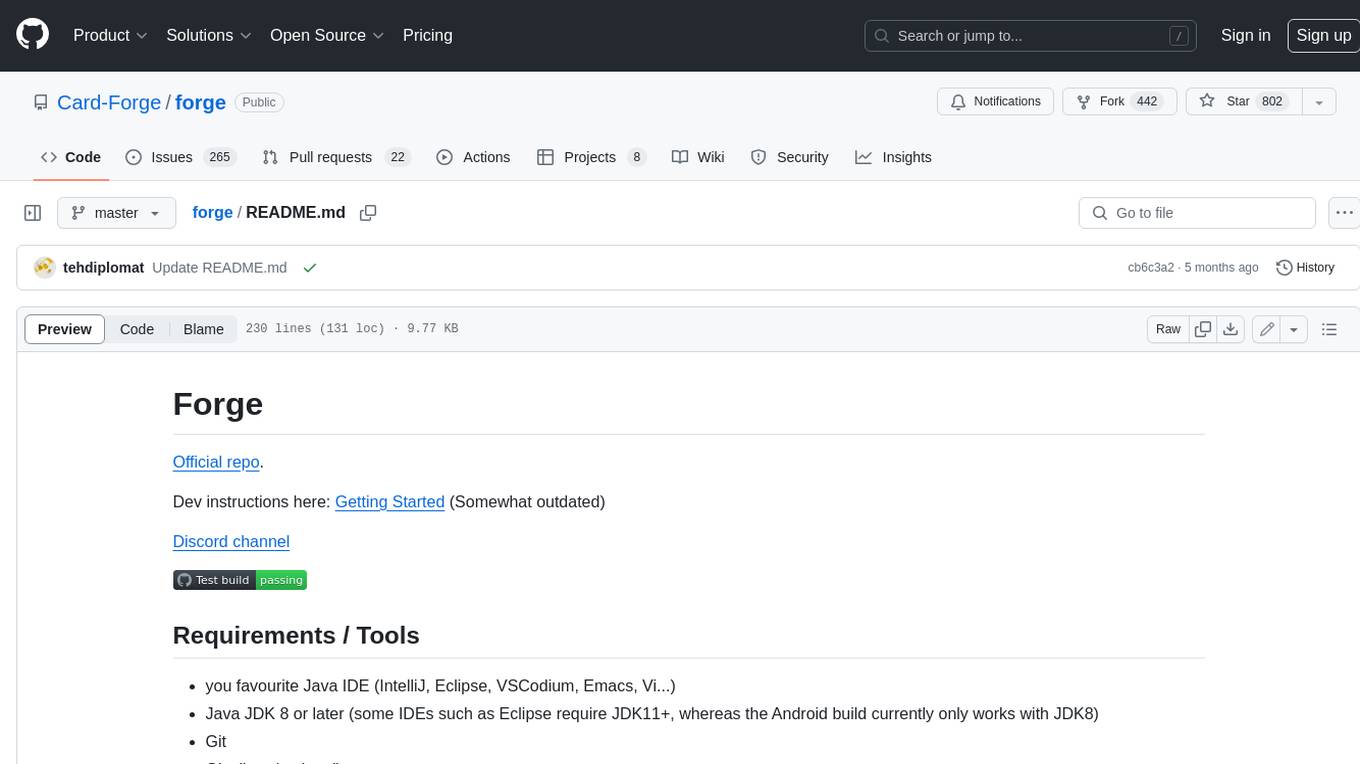
forge
Forge is a free and open-source digital collectible card game (CCG) engine written in Java. It is designed to be easy to use and extend, and it comes with a variety of features that make it a great choice for developers who want to create their own CCGs. Forge is used by a number of popular CCGs, including Ascension, Dominion, and Thunderstone.
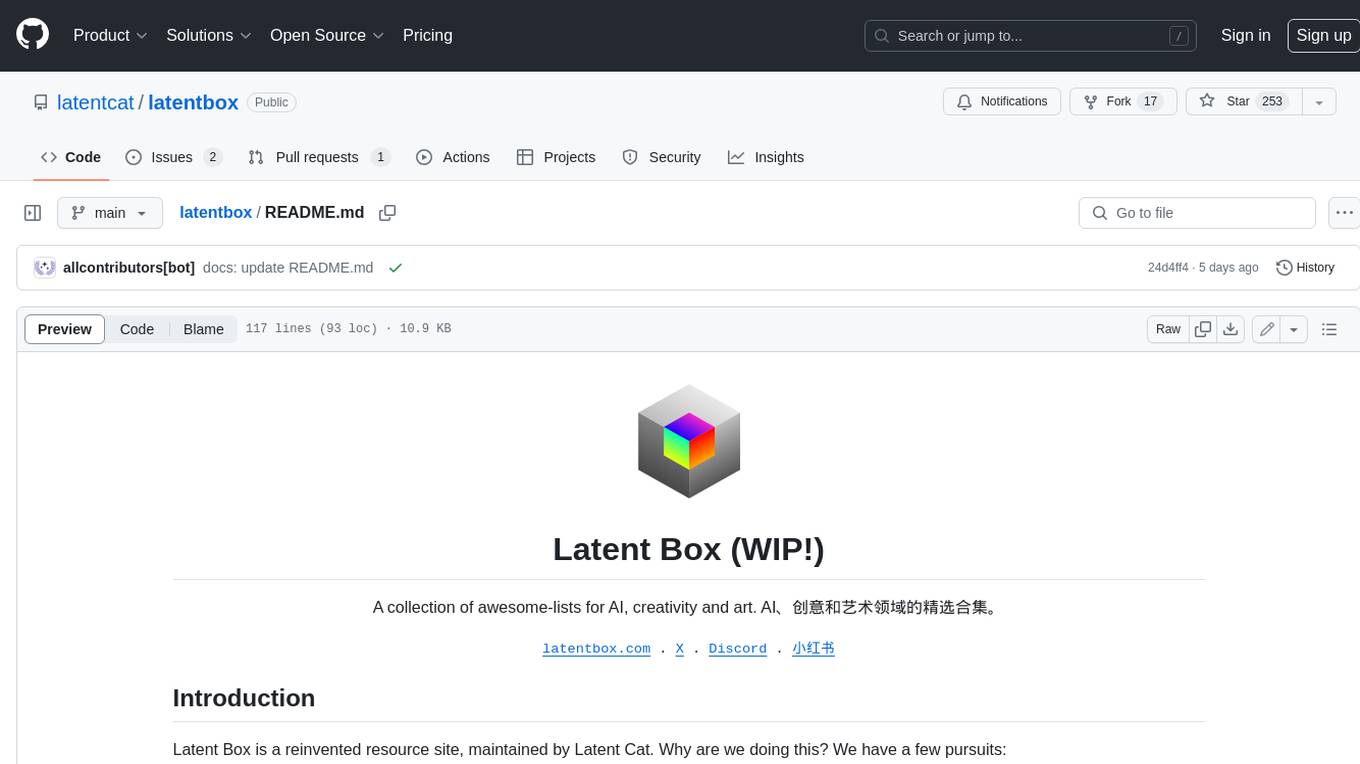
latentbox
Latent Box is a curated collection of resources for AI, creativity, and art. It aims to bridge the information gap with high-quality content, promote diversity and interdisciplinary collaboration, and maintain updates through community co-creation. The website features a wide range of resources, including articles, tutorials, tools, and datasets, covering various topics such as machine learning, computer vision, natural language processing, generative art, and creative coding.

fabric
Fabric is an open-source framework for augmenting humans using AI. It provides a structured approach to breaking down problems into individual components and applying AI to them one at a time. Fabric includes a collection of pre-defined Patterns (prompts) that can be used for a variety of tasks, such as extracting the most interesting parts of YouTube videos and podcasts, writing essays, summarizing academic papers, creating AI art prompts, and more. Users can also create their own custom Patterns. Fabric is designed to be easy to use, with a command-line interface and a variety of helper apps. It is also extensible, allowing users to integrate it with their own AI applications and infrastructure.
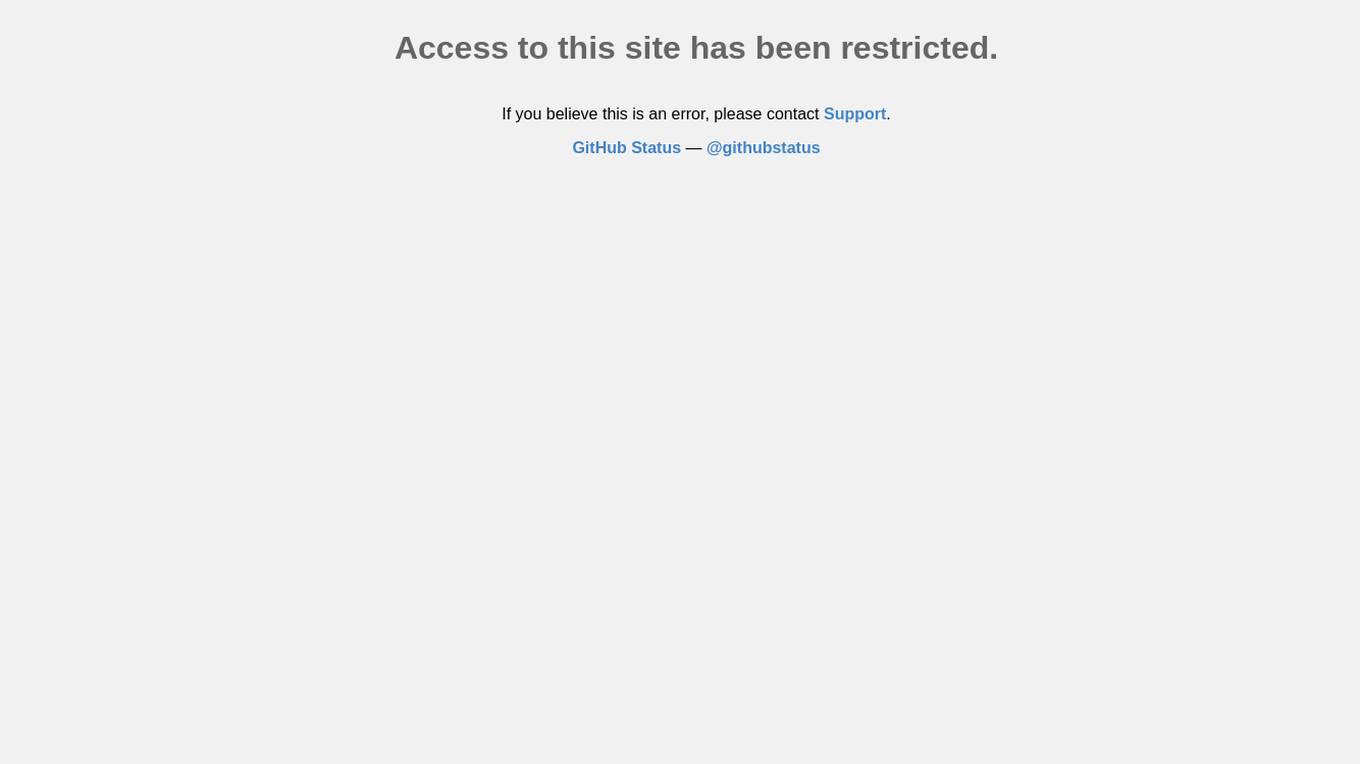
ColorPicker
ColorPicker Max is a powerful and intuitive color selection and manipulation tool that is designed to make working with color easier and more efficient than ever before. With its wide range of features and tools, ColorPicker Max offers an unprecedented level of control and customization over every aspect of color selection and manipulation.

ai-notes
Notes on AI state of the art, with a focus on generative and large language models. These are the "raw materials" for the https://lspace.swyx.io/ newsletter. This repo used to be called https://github.com/sw-yx/prompt-eng, but was renamed because Prompt Engineering is Overhyped. This is now an AI Engineering notes repo.
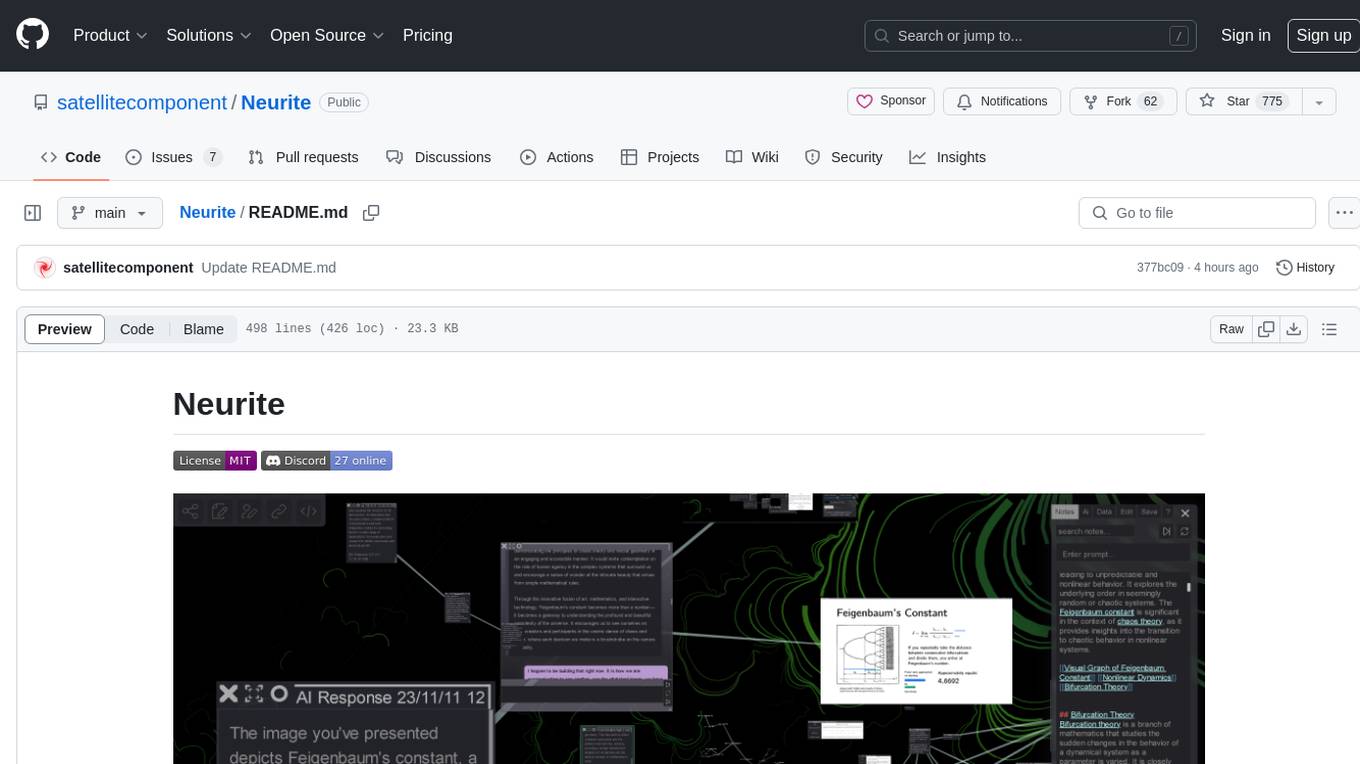
Neurite
Neurite is an innovative project that combines chaos theory and graph theory to create a digital interface that explores hidden patterns and connections for creative thinking. It offers a unique workspace blending fractals with mind mapping techniques, allowing users to navigate the Mandelbrot set in real-time. Nodes in Neurite represent various content types like text, images, videos, code, and AI agents, enabling users to create personalized microcosms of thoughts and inspirations. The tool supports synchronized knowledge management through bi-directional synchronization between mind-mapping and text-based hyperlinking. Neurite also features FractalGPT for modular conversation with AI, local AI capabilities for multi-agent chat networks, and a Neural API for executing code and sequencing animations. The project is actively developed with plans for deeper fractal zoom, advanced control over node placement, and experimental features.

ScribbleArchitect
ScribbleArchitect is a GUI tool designed for generating images from simple brush strokes or Bezier curves in real-time. It is primarily intended for use in architecture and sketching in the early stages of a project. The tool utilizes Stable Diffusion and ControlNet as AI backbone for the generative process, with IP Adapter support and a library of predefined styles. Users can transfer specific styles to their line work, upscale images for high resolution export, and utilize a ControlNet upscaler. The tool also features a screen capture function for working with external tools like Adobe Illustrator or Inkscape.